

Edinburgh Castle
Photos taken in August 2011
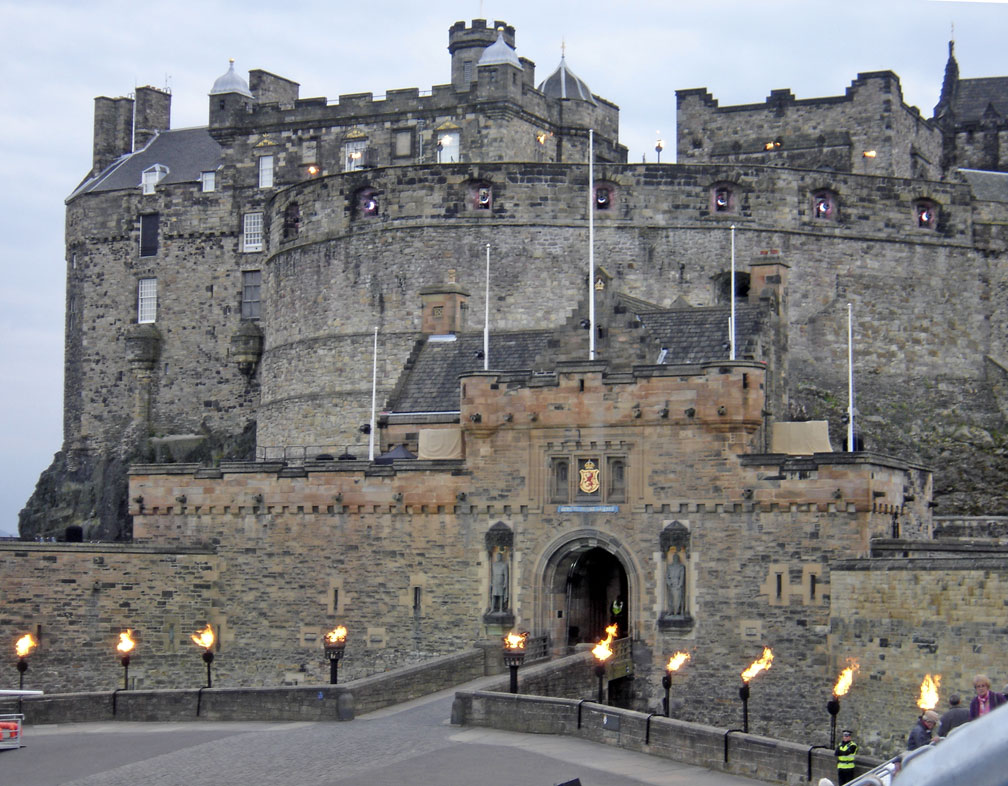
Edinburgh Castle
Edinburgh Castle is a fortress which dominates the skyline of the city of Edinburgh, Scotland, from its position atop the volcanic Castle Rock. Human habitation of the site is dated back as far as the 9th century BC, although the nature of early settlement is unclear. There has been a royal castle here since at least the reign of David I in the 12th century, and the site continued to be a royal residence until the Union of the Crowns in 1603. From the 15th century the castle's residential role declined, and by the 17th century its principal role was as a military base with a large garrison. Its importance as a historic monument was recognized from the 19th century, and various restoration programmes have been carried out since. As one of the most important fortresses in the Kingdom of Scotland, Edinburgh Castle was involved in many historical conflicts, from the Wars of Scottish Independence in the 14th century, up to the Jacobite Rising of 1745, and has been besieged, both successfully and unsuccessfully, on several occasions.
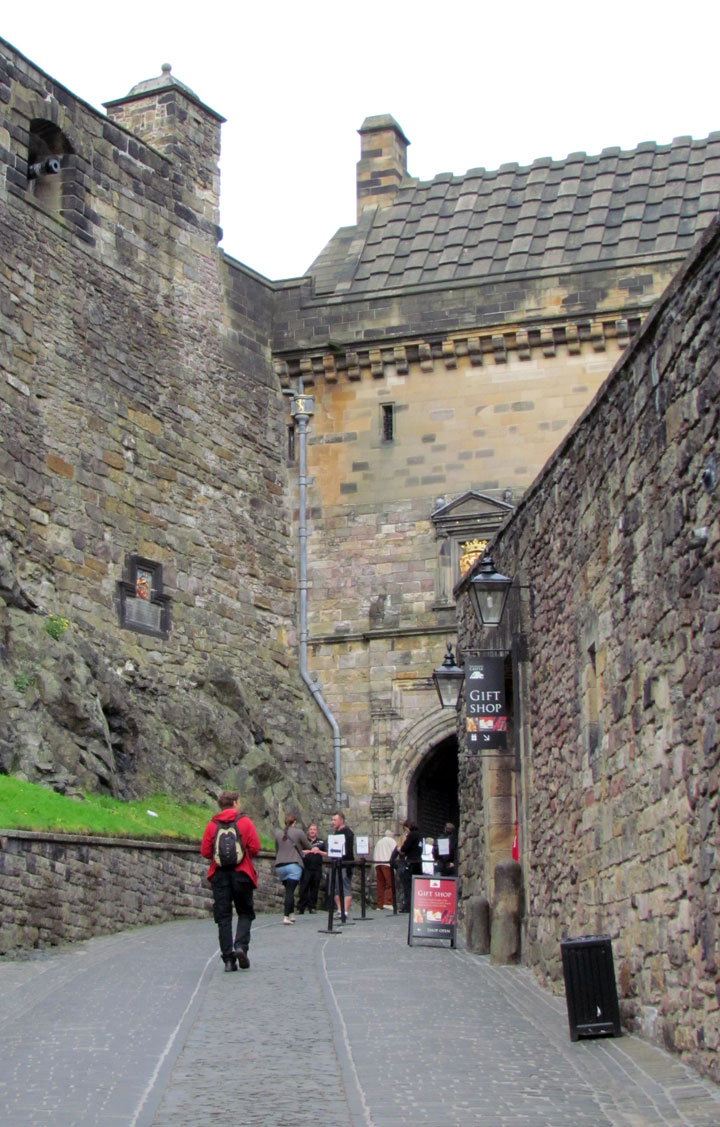
Few of the present buildings pre-date the Lang Siege of the 16th century, when
the medieval fortifications were largely destroyed by artillery bombardment. The
notable exception is St Margaret's Chapel, the oldest surviving building in
Edinburgh, which dates from the early 12th century. Among other significant
buildings of the castle are the Royal Palace, and the early-16th-century Great
Hall. The castle also houses the Scottish National War Memorial, and the
National War Museum of Scotland.

Although formally owned by the Ministry of Defence, most of the castle is now in
the care of Historic Scotland, and it is Scotland's most-visited paid tourist
attraction. The garrison left in the 1920s, but there is still a military
presence at the castle, largely ceremonial and administrative, and including a
number of regimental museums. It is the backdrop to the annual
Edinburgh Military Tattoo
and has become a recognisable symbol of Edinburgh and of Scotland.
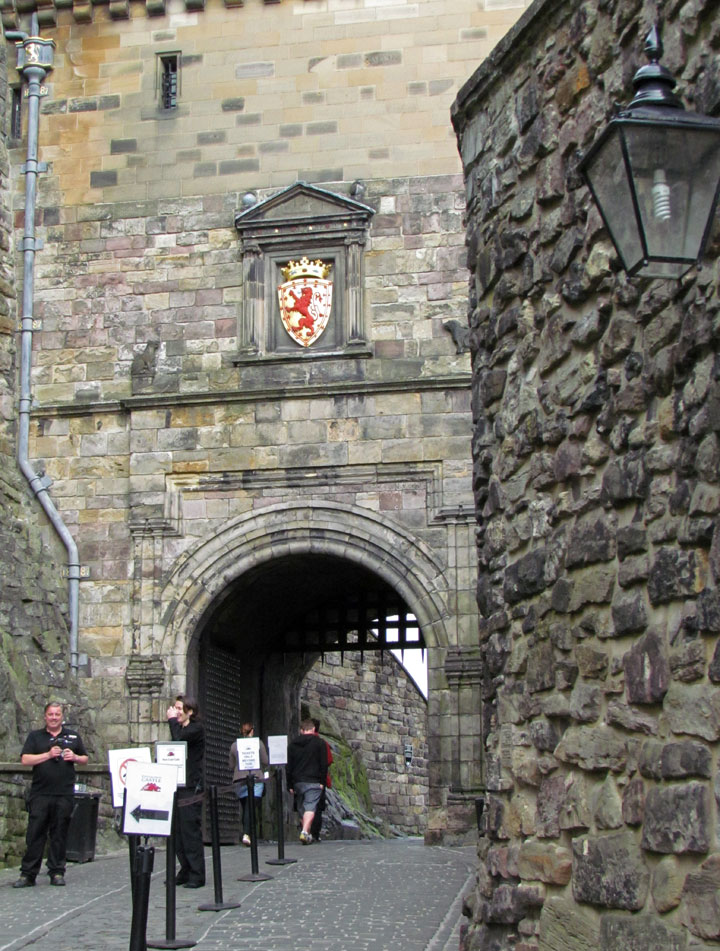
The castle stands upon the plug of an extinct volcano, which is estimated to have risen some 350 million years ago during the lower Carboniferous period. The Castle Rock is the remains of a volcanic pipe, which cut through the surrounding sedimentary rock, before cooling to form very hard dolerite, a type of basalt. Subsequent glacial erosion was resisted by the dolerite, which protected the softer rock to the east, leaving a crag and tail formation.

The summit of the Castle Rock is 130 metres (430 ft) above sea level, with rocky cliffs to the south, west and north, rearing up to 80 metres (260 ft) from the surrounding landscape. This means that the only readily accessible route to the castle lies to the east, where the ridge slopes more gently. The defensive advantage of such a site is clear, but the geology of the rock also presents difficulties, since basalt is an extremely poor aquifer. Providing water to the Upper Ward of the castle was problematic, and despite the sinking of a 28-metre (92 ft) deep well, the water supply often ran out during drought or siege, for example during the Lang Siege of 1573.
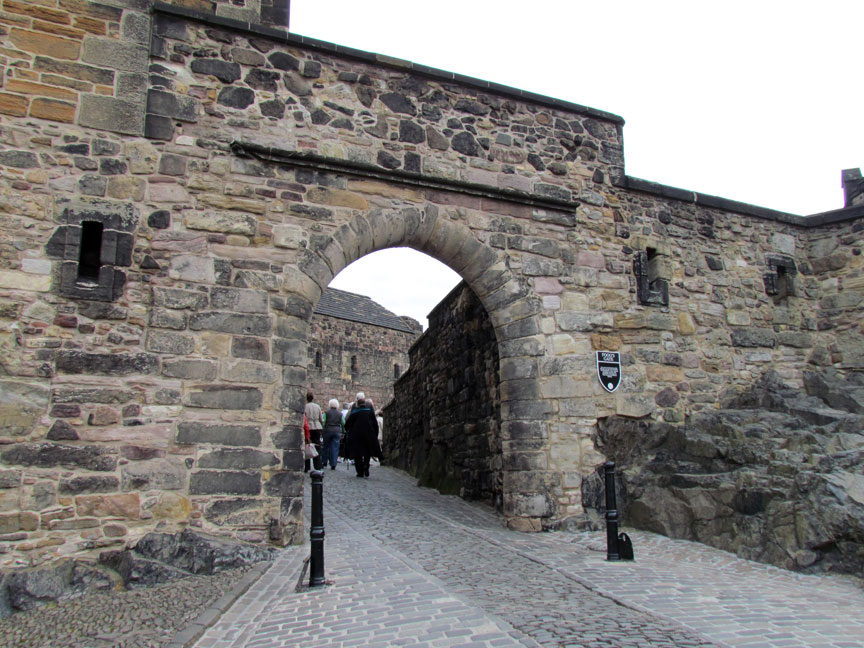
Documentary reference to occupation of the Castle Rock can be found as early as
the mid-2nd century AD.[8] Ptolemy (c. 83 c. 168) refers to a settlement of
the Votadini known to the Romans as "Alauna", meaning "rock place", which may be
the earliest known name for the Castle Rock. The Orygynale Cronykil of Andrew of
Wyntoun (c. 1350 c. 1423), an early chronicler of Scottish history, alludes to
"Ebrawce" (Ebraucus), a legendary King of the Britons, who "byggyd [built]
Edynburgh". According to the earlier chronicler, Geoffrey of Monmouth (c. 1100
c. 1155), Ebraucus had fifty children by his twenty wives, and was the founder
of "Kaerebrauc" (York), "Alclud" (Dumbarton), and the "Maidens' Castle". John
Stow (c. 1525 1605), credited Ebraucus with building "the Castell of Maidens
called Edenbrough" in 989 BC.
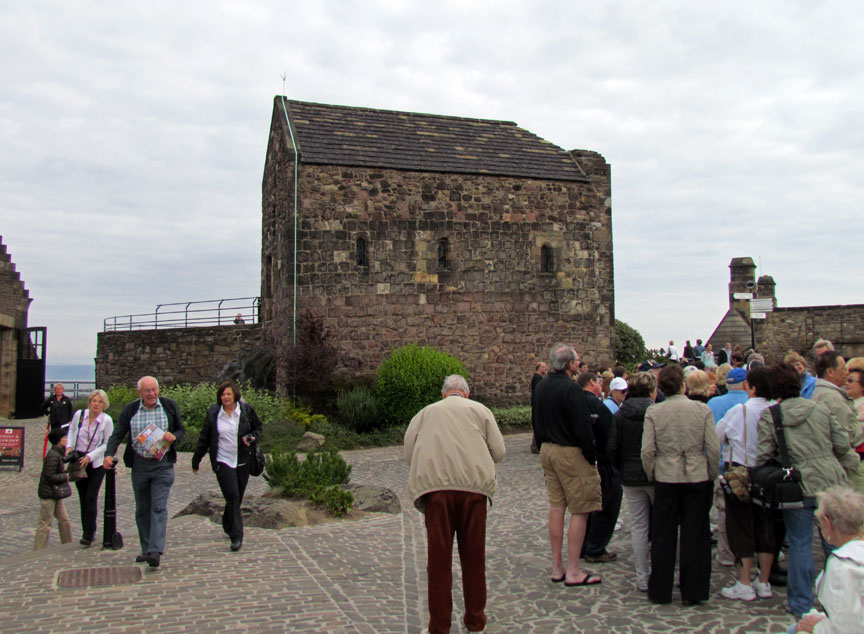
The name "Maiden Castle", or
Castellum Puellarum in Latin, was commonly used until at least the 16th
century. It appears in charters of David I (ruled 11241153) and his
successors, although its origins are obscure. William Camden's 1607 Britannia
records that "the Britans called [it] Castle Myned Agned, the Scots, the Maidens
Castle and the Virgins Castle, of certaine young maidens of the Picts roiall
bloud who were kept there in old time". According to the 17th-century
antiquarian Father Richard Hay, the "maidens" were a group of nuns, who were
ejected from the castle and replaced by canons, considered "fitter to live among
soldiers". However, this story has been considered "apocryphal" by Daniel Wilson
and later historians. Possibly the name derives from a "Cult of the Nine
Maidens" type of legend. Arthurian legends suggest that the site once held a
shrine to Morgain la Fee, one of nine sisters. Later, St Monenna is said to have
invested a church at Edinburgh, as well as at Dumbarton and other places, and is
also said to have been one of nine companions. More simply, the term "Maiden
Castle" may refer to a castle which has never been taken by force.
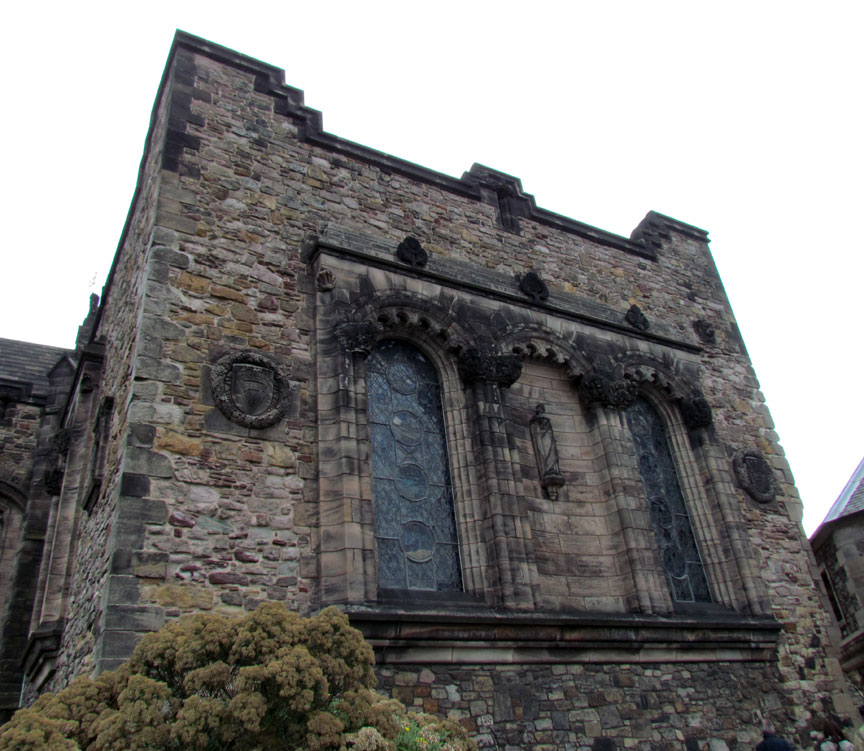
An archaeological survey of the castle in the late 1980s shows evidence of the
site having been settled during the late Bronze Age or early Iron Age,
potentially making the Castle Rock the longest continually occupied site in
Scotland. However, the extent of the finds was not particularly significant and
was insufficient to draw any certain conclusions about the precise nature or
scale of this earliest known phase of occupation.
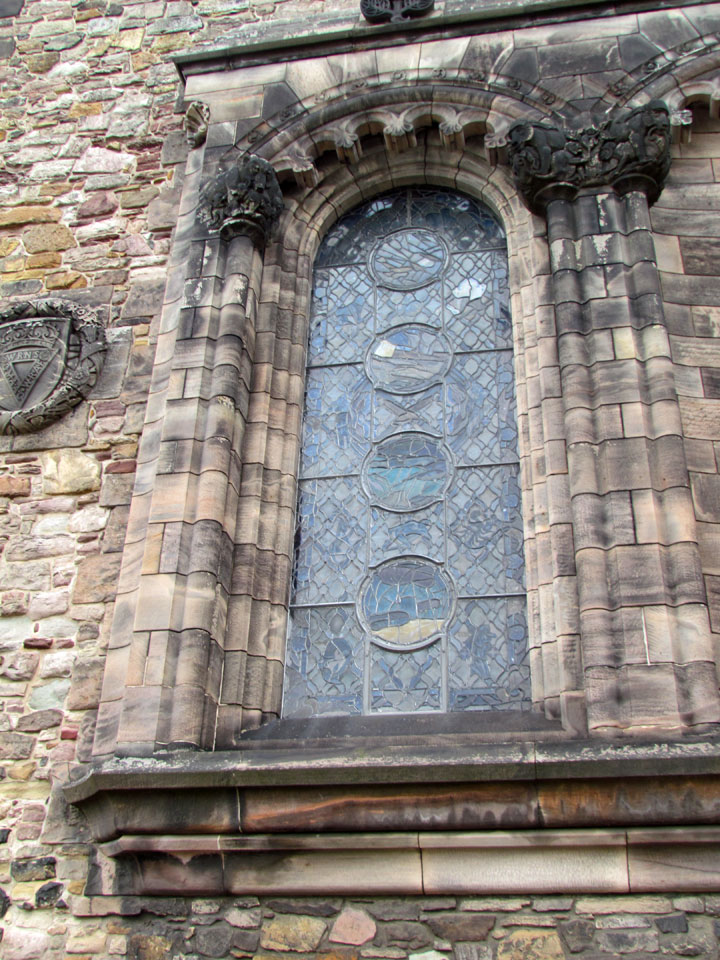
The archaeological evidence becomes more compelling in the Iron Age.
Traditionally, it had been supposed that the tribes which inhabited this part of
central Scotland had made little or no use of the Castle Rock. Excavations at
nearby Traprain Law, Dunsapie Hill, Duddingston and Inveresk had revealed
relatively large settlements and it was supposed that these sites had, for some
reason, been chosen in preference to the Castle Rock. However, the excavations
of the 1980s suggested that there was probably an enclosed hill fort on the
rock, although only the fringes of the site were excavated. House fragments
revealed were similar to Votadini houses previously found in Northumbria.
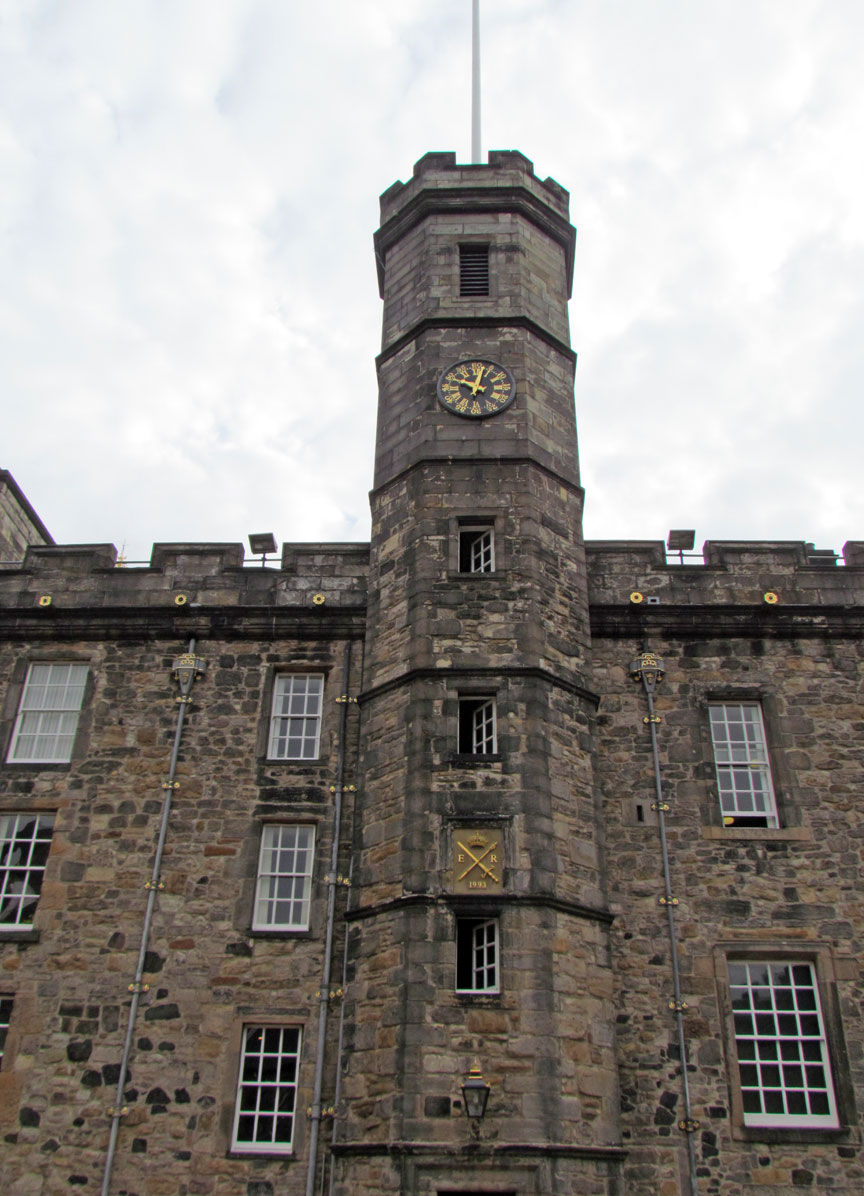
Royal Palace
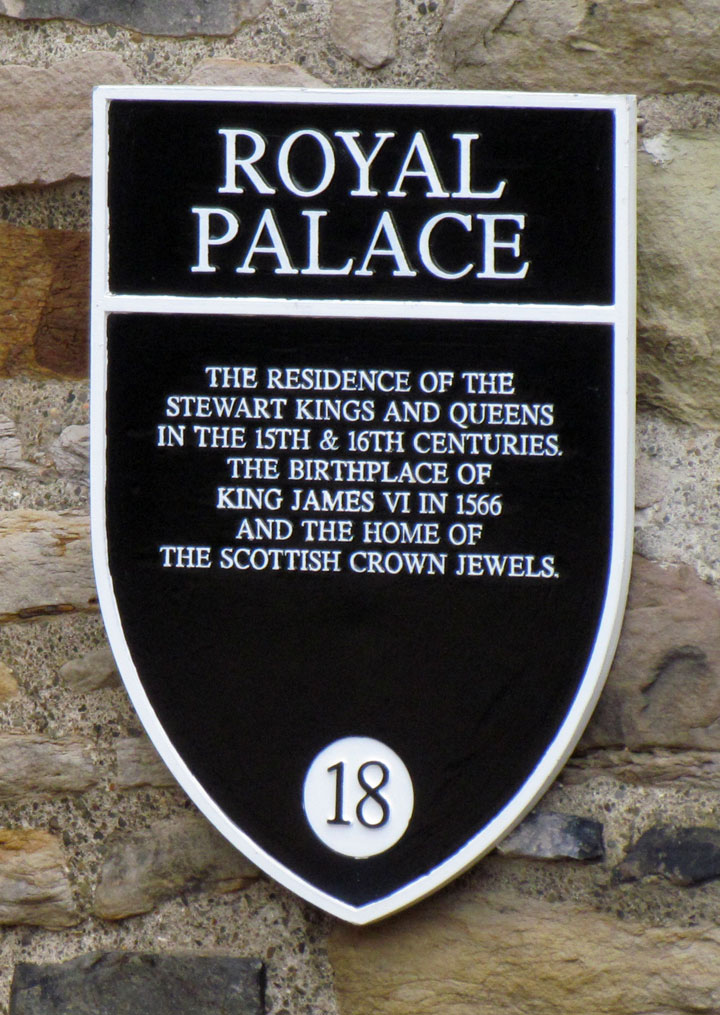
The dig revealed clear signs of habitation from the 1st and 2nd centuries AD,
consistent with Ptolemy's reference to "Alauna". Signs of occupation included a
good deal of Roman material, including pottery, bronzes and brooches,
potentially reflecting a trading relationship between the Votadini and the
Romans beginning with Agricola's foray north in AD 80, and continuing through to
the establishment of the Antonine Wall around AD 140, when the Romans
temporarily established themselves nearby at Cramond. The nature of the
settlement at this time is inconclusive, but Driscoll and Yeoman suggest it may
have been a broch, similar to the one at Edin's Hall in the Borders. There is no
evidence that the Romans actually occupied the Castle Rock, as they did at
nearby Traprain Law. From this point onwards there is strong evidence pointing
towards continuous habitation of the site through to the present, albeit with
fluctuations in population levels.
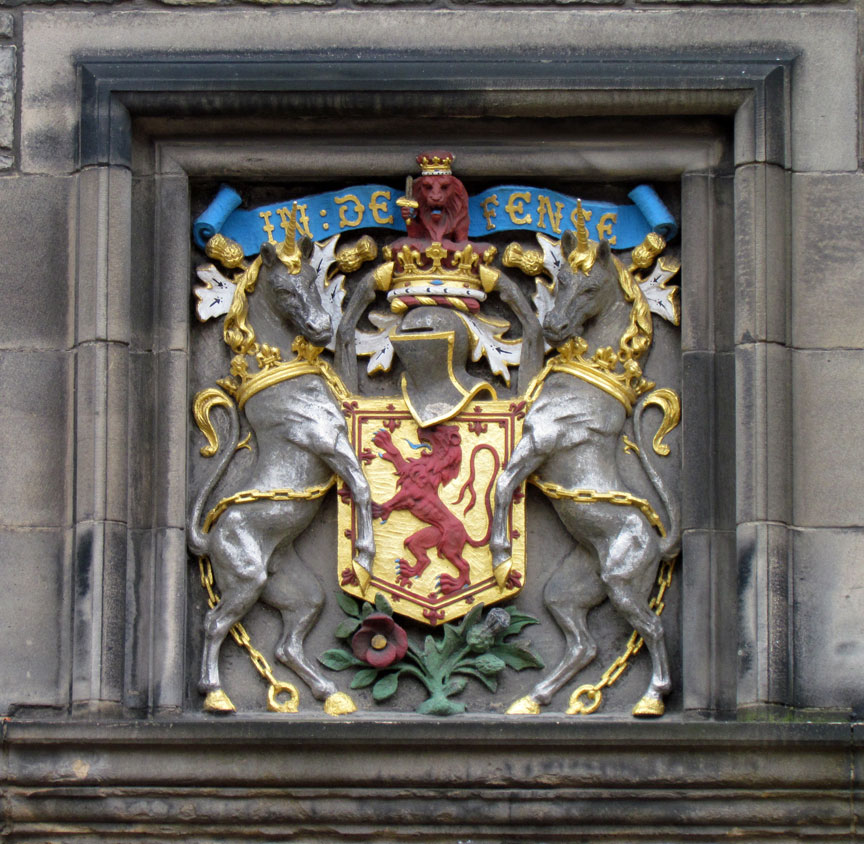
The castle does not re-appear in contemporary historical records from the time of Ptolemy until around AD 600. Then, in the Brythonic epic Y Gododdin, there is a reference to Din Eidyn, "the stronghold of Eidyn". This has been viewed as an early reference to the Castle Rock. The poem tells of the Gododdin King Mynyddog Mwynfawr, and his band of warriors, who, after a year of feasting in their fortress, set out to do battle with the Angles in the area of contemporary Yorkshire. Despite performing glorious deeds of valour and bravery, the poem relates that the Gododdin were massacred.
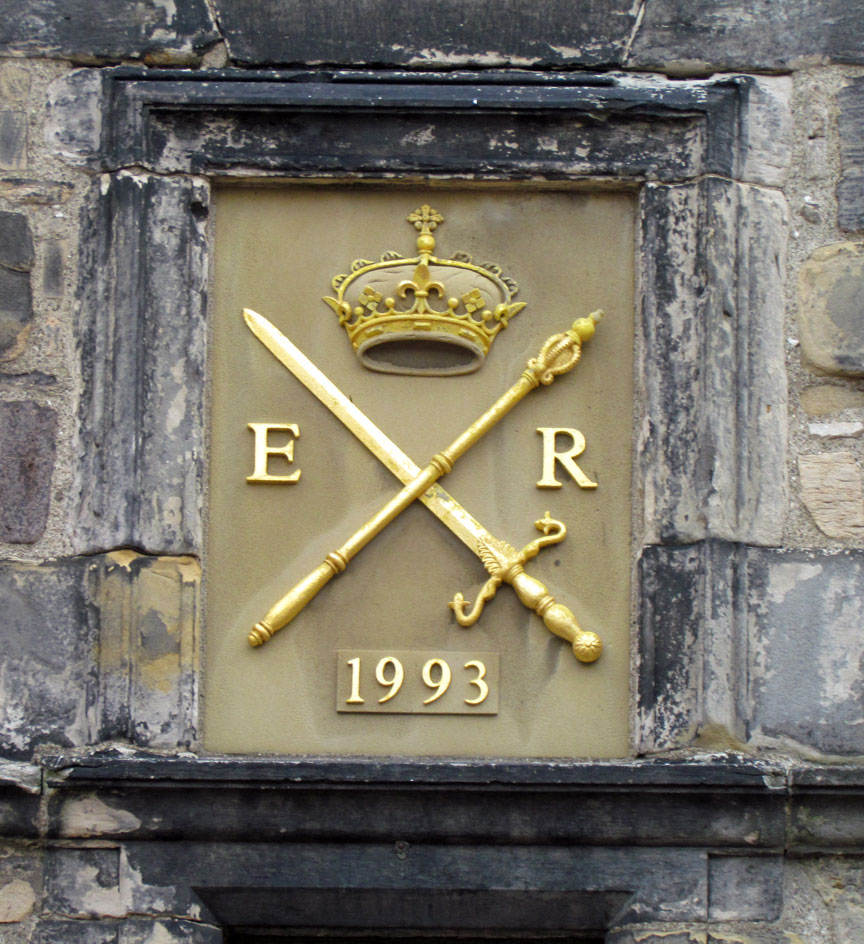
The Irish annals record that in 638, after the events related in Y Gododdin, "Etin"
was besieged by the Angles under Oswald of Northumbria, and the Gododdin were
defeated. The territory around Edinburgh then became part of the Kingdom of
Northumbria, which was itself absorbed by England in the 10th century, when
Athelstan of England, according to the Annals of Clonmacnoise, "spoiled the
Kingdom of Edinburgh". The English withdrew, and Lothian became part of
Scotland, during the reign of Indulf (ruled 954962).
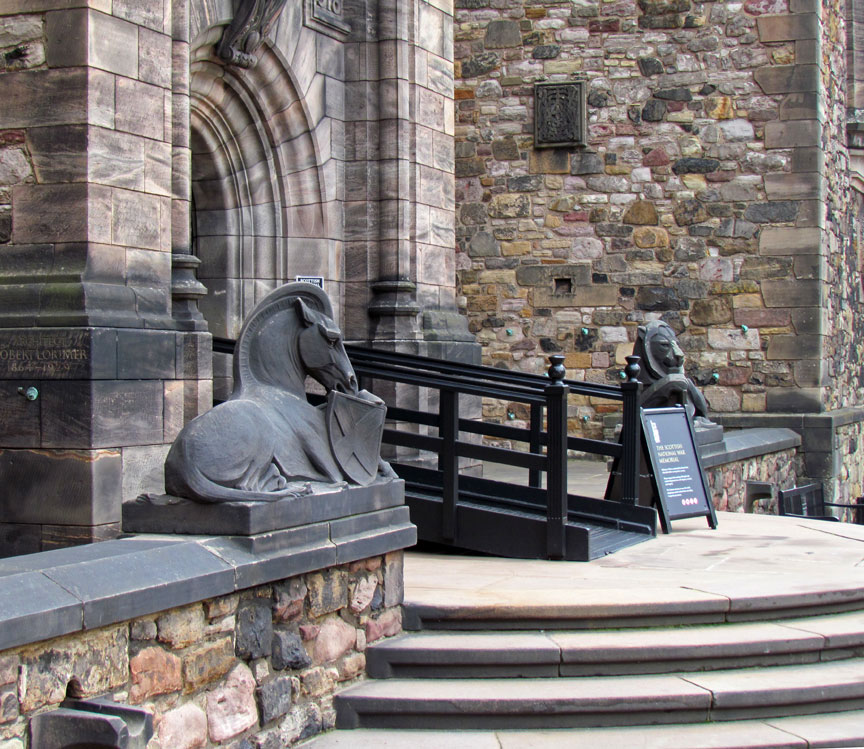
The archaeological evidence for the relevant period is entirely based on
analysis of midden heaps, with no evidence of structures. Few conclusions can
therefore be derived about the status of the settlement during this period,
although the midden deposits show no clear break since Roman times.
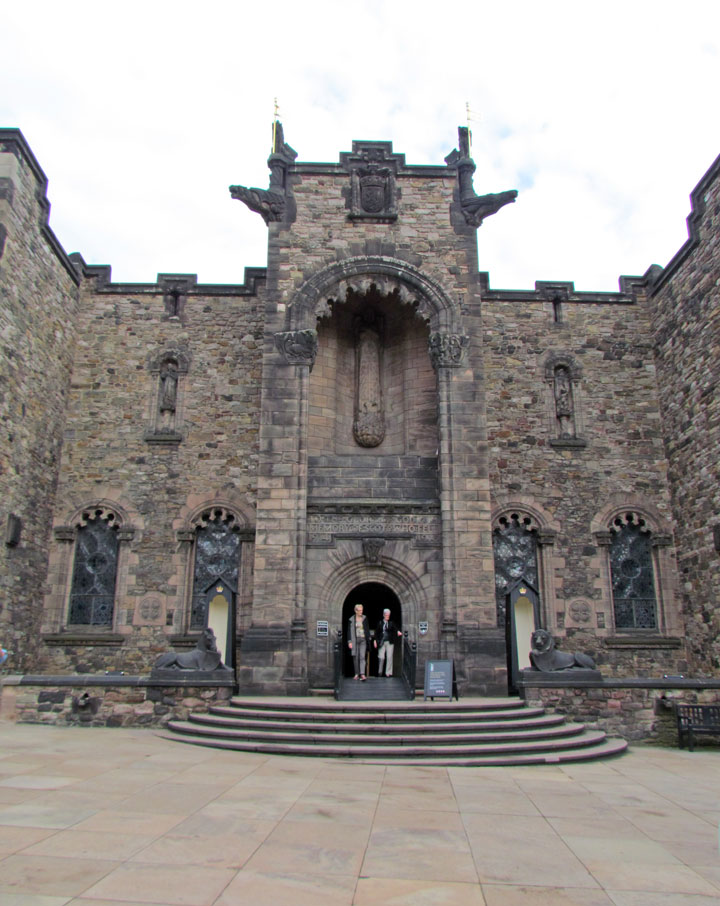
Serviceman's Memorial
The first documentary reference to a castle at Edinburgh is in John of Fordun's account of the death of King Malcolm III. Fordun places his widow, the future Saint Margaret, at the "Castle of Maidens", where she learns of his death in November 1093. Fordun's account goes on to relate how Margaret died of grief within days, and how Malcolm's brother Donald Bane laid siege to the castle. However, Fordun's chronicle was not written until the later 14th century, and the near-contemporary account of the life of St Margaret, by Bishop Turgot, makes no mention of a castle. During the reigns of Malcolm III and his sons, Edinburgh Castle became one of the most significant royal centres in Scotland. Malcolm's son King Edgar died here in 1107.

Malcolm's youngest son, King David I (ruled 11241153), developed Edinburgh as a
site of royal power principally through his administrative reforms. Between 1139
and 1150, David held an assembly of nobles and churchmen, a precursor to the
parliament of Scotland, at the castle. Any buildings or defences would probably
have been of timber, although two 12th-century stone buildings are known. Of
these, St. Margaret's Chapel remains at the summit of the rock. The second was a
church, dedicated to St. Mary, which stood on the site of the Scottish National
War Memorial. Given that the southern part of the Upper Ward (where Crown Square
is now sited) was not suited to being built upon until the construction of the
vaults in the 15th century, it seems probable that any earlier buildings would
have been located towards the northern part of the rock; that is around the area
where St. Margaret's Chapel stands. This has led to a suggestion that the chapel
is the last remnant of a square, stone keep, which would have formed the bulk of
the 12th-century fortification. The structure may have been similar to the keep
of Carlisle Castle, which David I began after 1135.
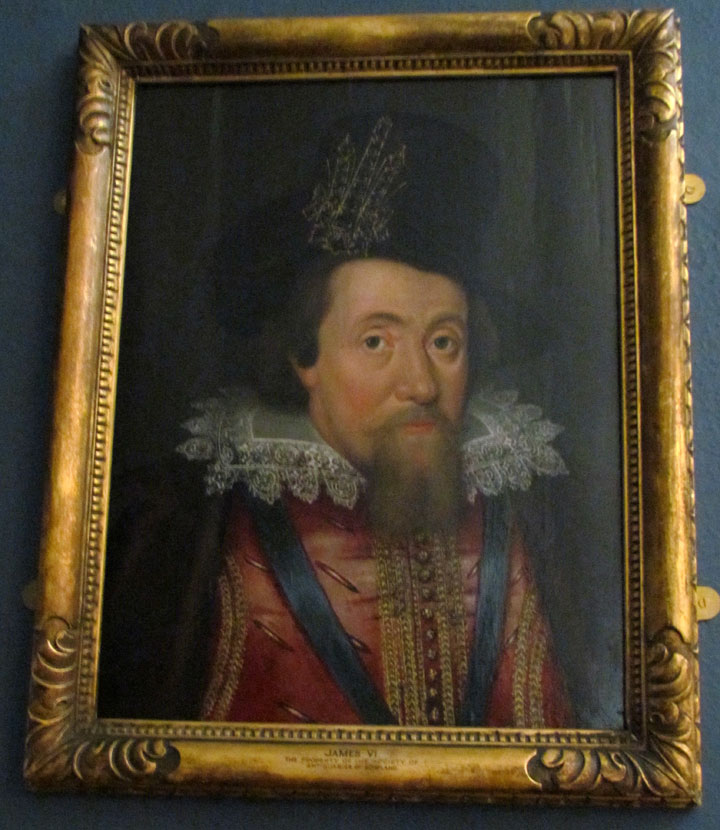
David's successor King Malcolm IV (ruled 11531165) reportedly stayed at
Edinburgh more than at any other location. But in 1174, King William "the Lion"
(ruled 11651214) was captured by the English at the Battle of Alnwick. He was
forced to sign the Treaty of Falaise to secure his release, in return for
surrendering Edinburgh Castle, along with the castles of Berwick, Roxburgh and
Stirling, to the English King, Henry II. The castle was occupied by the English
for twelve years, until 1186, when it was returned to William as the dowry of
his English bride, Ermengarde de Beaumont, who had been chosen for him by King
Henry. By the end of the 12th century, Edinburgh Castle was established as the
main depository of the national archives.
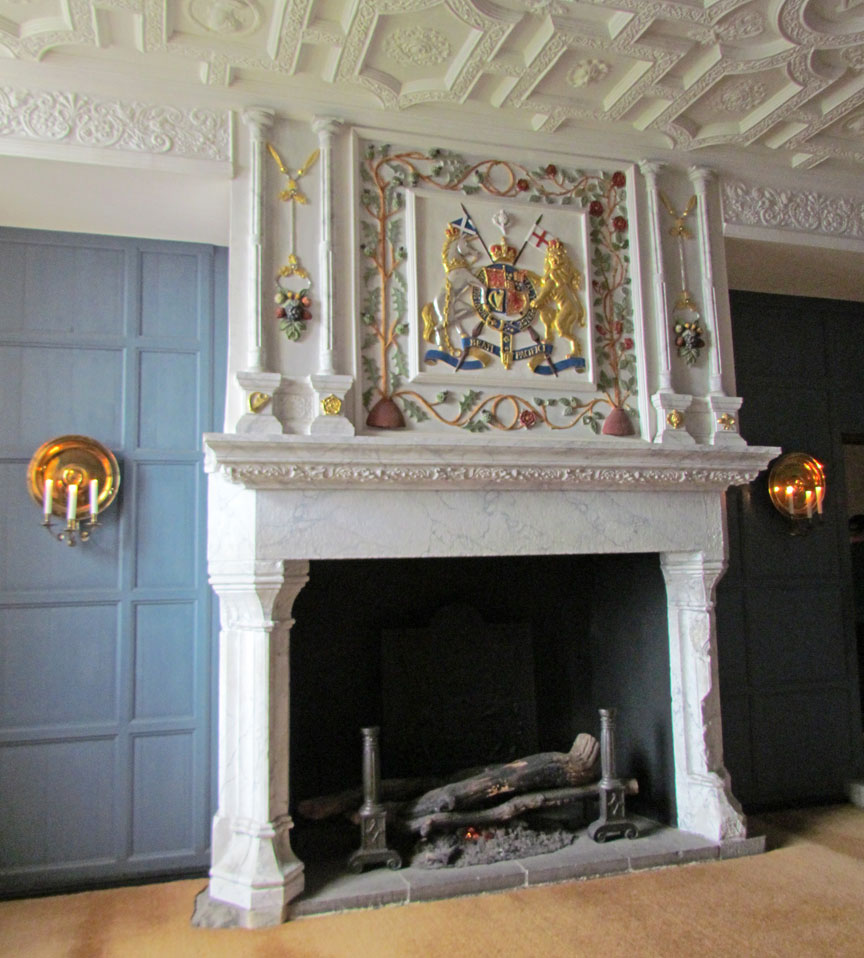

A century later, on the death of King Alexander III, the throne of Scotland
became vacant. Edward I of England was appointed to adjudicate the competing
claims for the Scottish crown, but attempted to use the opportunity to establish
himself as the feudal overlord of Scotland. During the negotiations, Edward
stayed briefly at Edinburgh Castle, and had much of the country's records and
treasure removed from the castle to England.
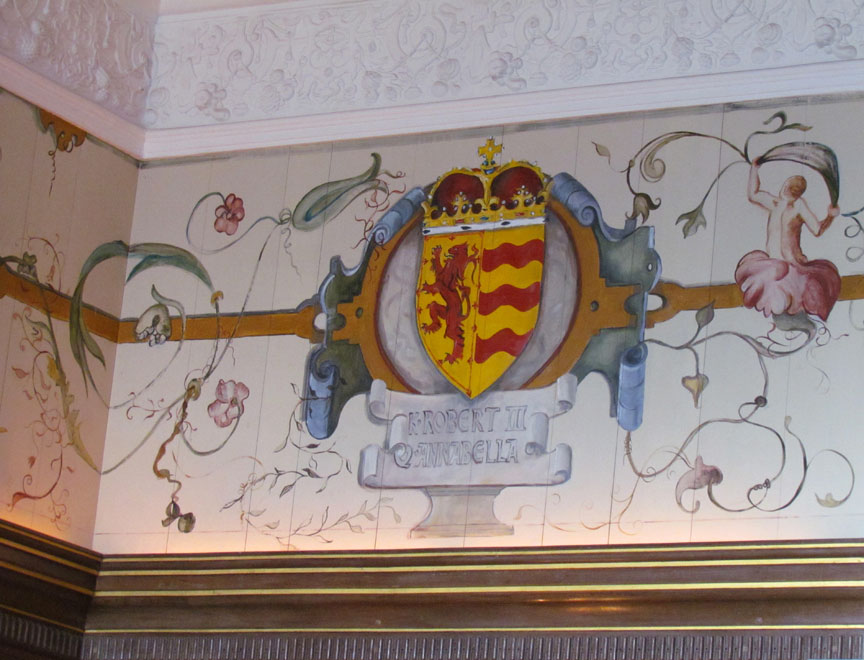
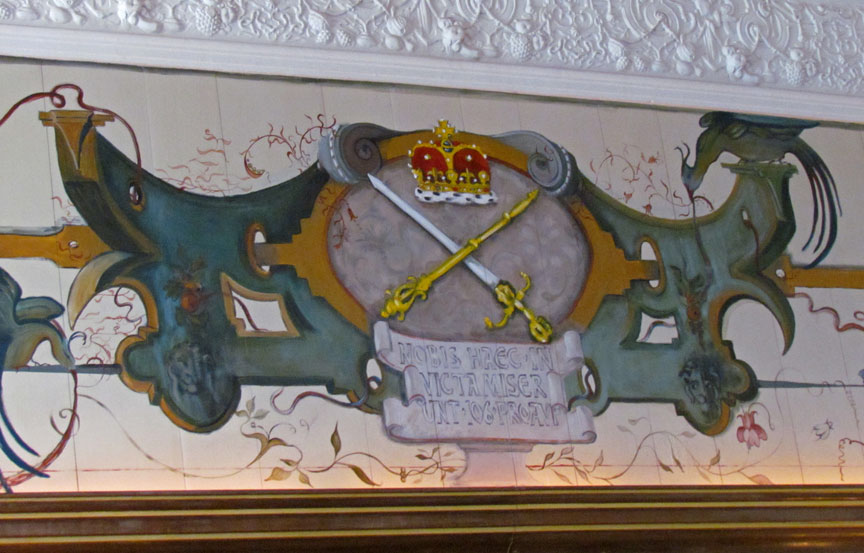
In March 1296, Edward I launched an invasion of Scotland, sparking the First War
of Scottish Independence. Edinburgh Castle soon came under English control,
surrendering after three days of bombardment. A large garrison was installed,
325 strong in 1300, and Edward brought up his master craftsmen from the Welsh
castles, including Thomas de Houghton and Master Walter of Hereford, both of
whom travelled from Wales to Edinburgh in the first years of the century. After
the death of Edward I in 1307, however, England's control over Scotland
weakened. On 14 March 1314, a surprise night attack by Thomas Randolph, 1st Earl
of Moray, recaptured the castle. The daring plan involved a party of thirty
hand-picked men, led by one William Francis, who had lived in the castle as a
boy, making a difficult ascent up the north face of the Castle Rock, and taking
the garrison by surprise. Robert the Bruce immediately ordered the destruction
of the castle's defences to prevent re-occupation by the English. Shortly after,
Bruce's army secured victory at the Battle of Bannockburn.

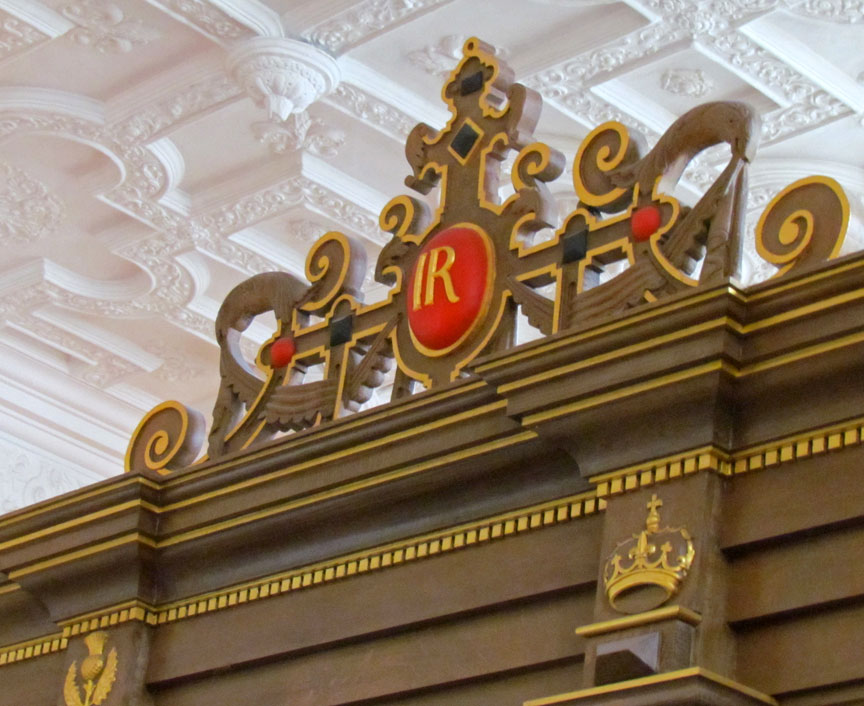
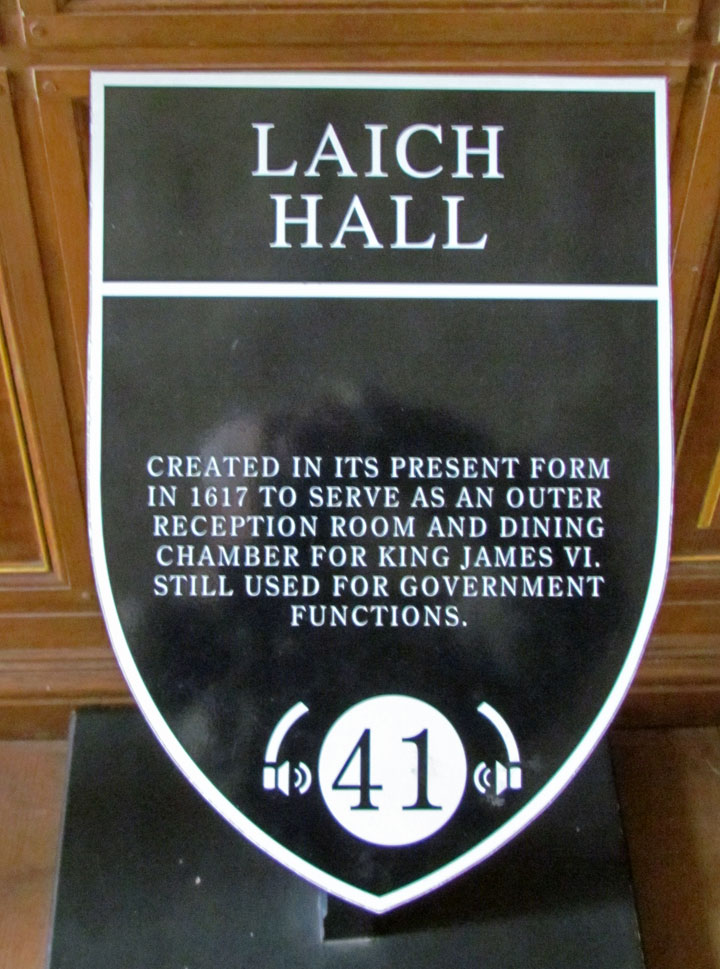
After Bruce's death in 1329, Edward III of England determined to carry on Edward
I's project, and supported the claim of Edward Balliol, son of the former King
John Balliol, over that of the young David II, son of the Bruce. Edward invaded
in 1333, marking the start of the Second War of Scottish Independence, and the
English forces reoccupied and refortified Edinburgh Castle in 1335, holding it
until 1341. This time, the Scottish assault was led by William Douglas, 1st Earl
of Douglas. Douglas's party disguised themselves as merchants bringing supplies
to the garrison. Driving a cart into the castle, they halted it to prevent the
gates closing. A larger force hidden nearby rushed to join them, and the castle
was retaken. The English garrison, numbering 100, were all killed.
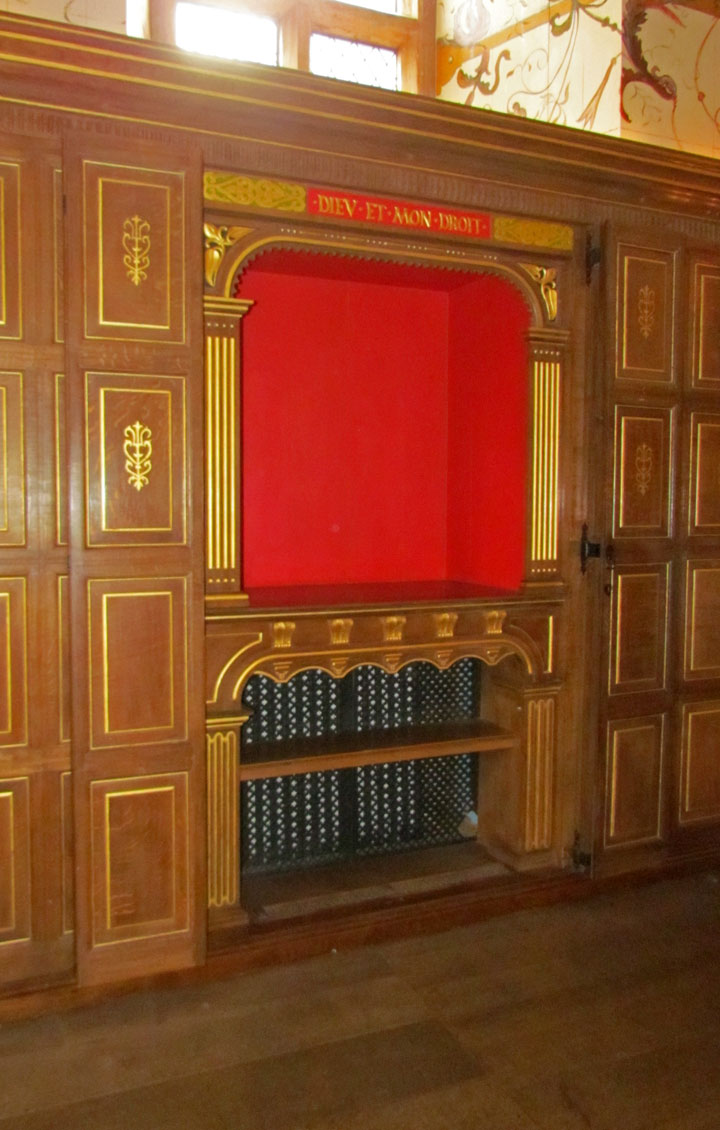
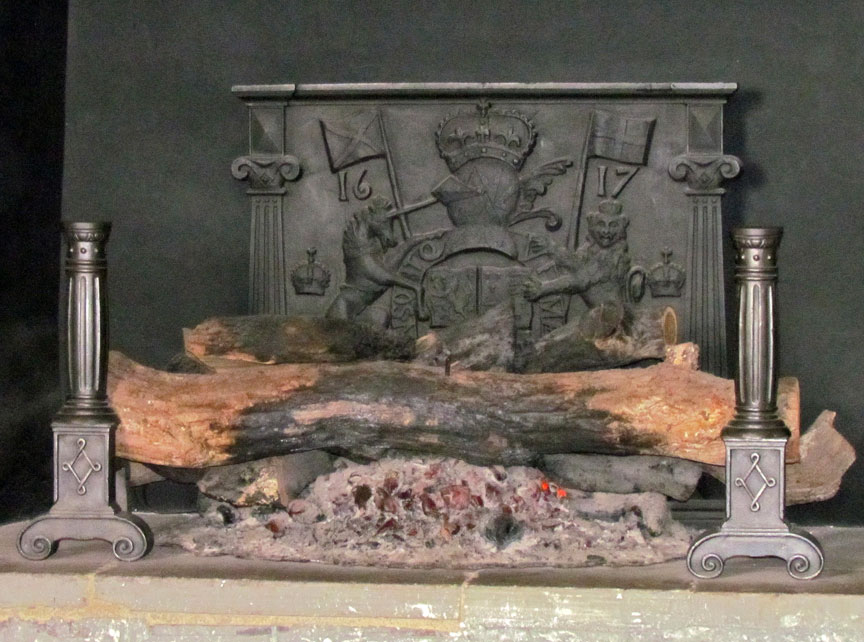
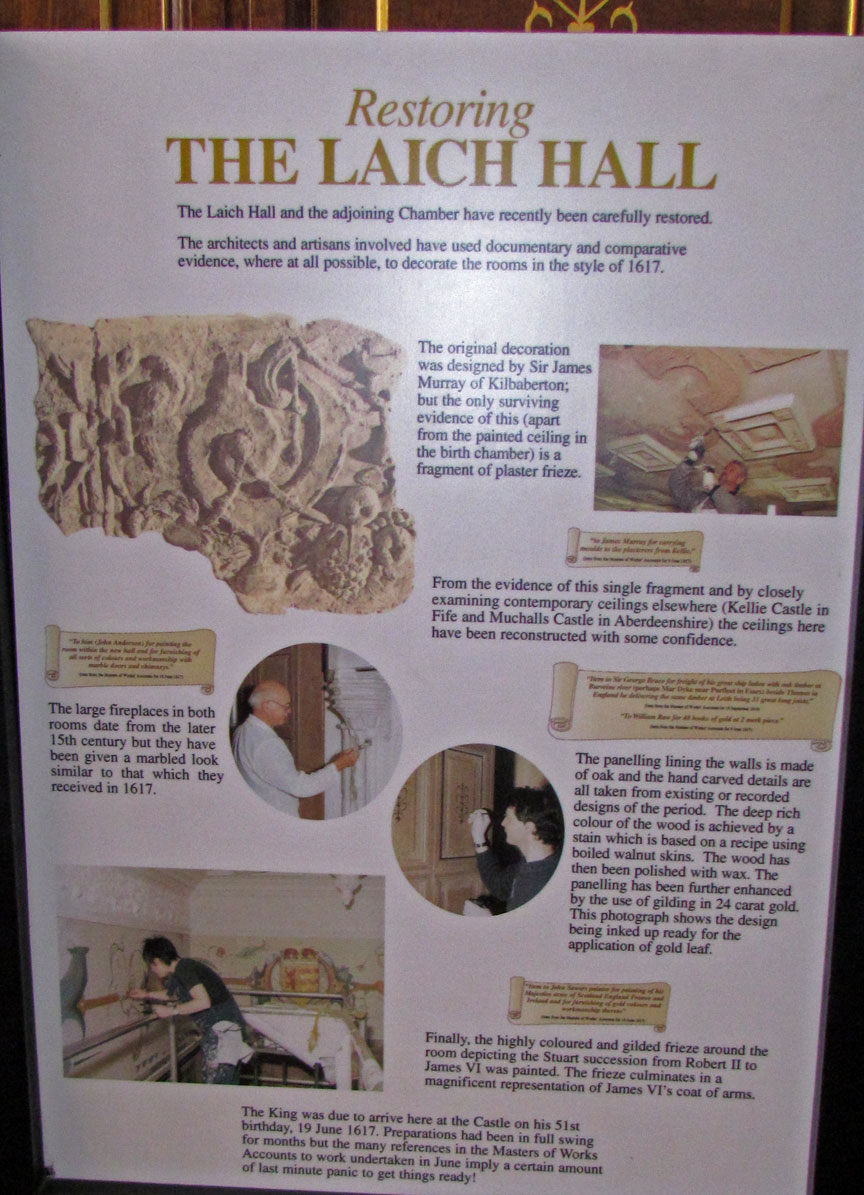
The Treaty of Berwick of 1357 brought the Wars of Independence to a close. David
II resumed his rule, and set about rebuilding Edinburgh Castle, which became his
principal seat of government. David's Tower was begun around 1367, and was
incomplete when David died at the Castle in 1371, being completed by his
successor, Robert II, in the 1370s. The tower stood on the site of the present
Half Moon Battery, and was connected by a section of curtain wall to the smaller
Constable's Tower, a round tower built between 1375 and 1379 where the
Portcullis Gate now stands.
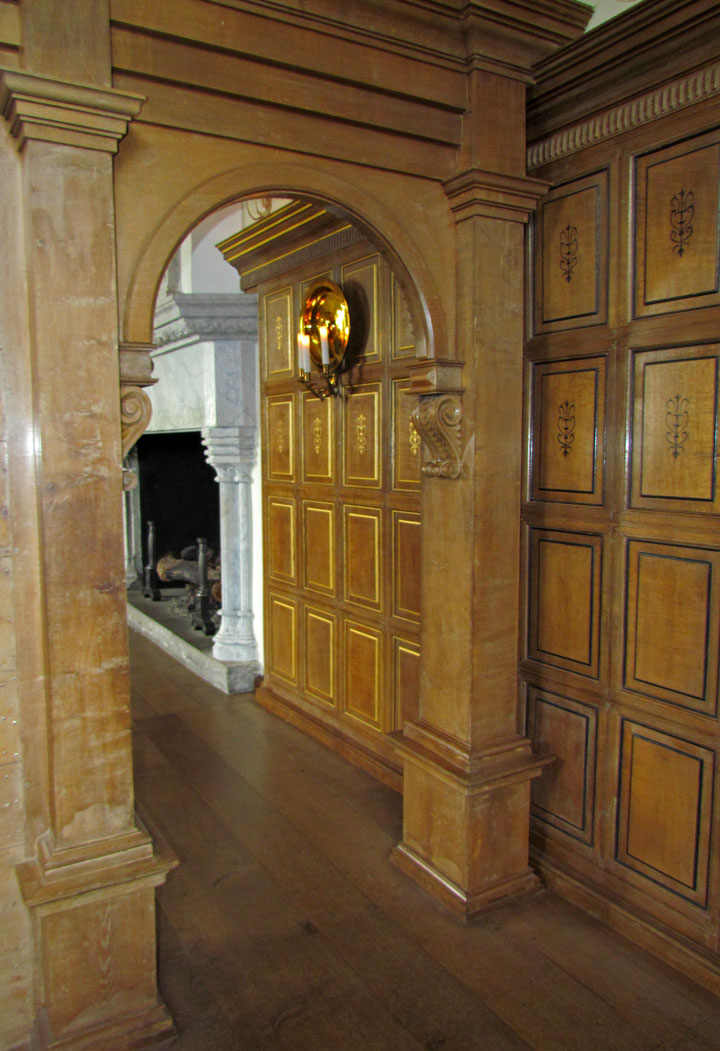
In the early 15th century, another
English invasion, this time under Henry IV, reached Edinburgh Castle and began a
siege, but due to a lack of supplies, the English withdrew. From 1437, Sir
William Crichton was Keeper of Edinburgh Castle, and soon after became
Chancellor of Scotland. In an attempt to gain the regency of Scotland, Crichton
sought to overthrow the power of the Earls of Douglas, the principal noble
family in the kingdom. The sixteen-year-old William Douglas, 6th Earl of
Douglas, and his younger brother David, were summoned to Edinburgh Castle in
November 1440. The so-called "Black Dinner" which followed saw the two boys
summarily beheaded on trumped-up charges, in the presence of the ten-year-old
King James II (ruled 14371460). Douglas' supporters subsequently laid siege to
the castle, causing some damage. Construction continued throughout this period,
with the area now known as Crown Square being laid out over vaults in the 1430s.
Royal apartments were built, forming the nucleus of the later palace block, and
a Great Hall was in existence by 1458. In 1464, the access to the castle was
improved, with the current approach road up the north-east side of the rock
being laid out.
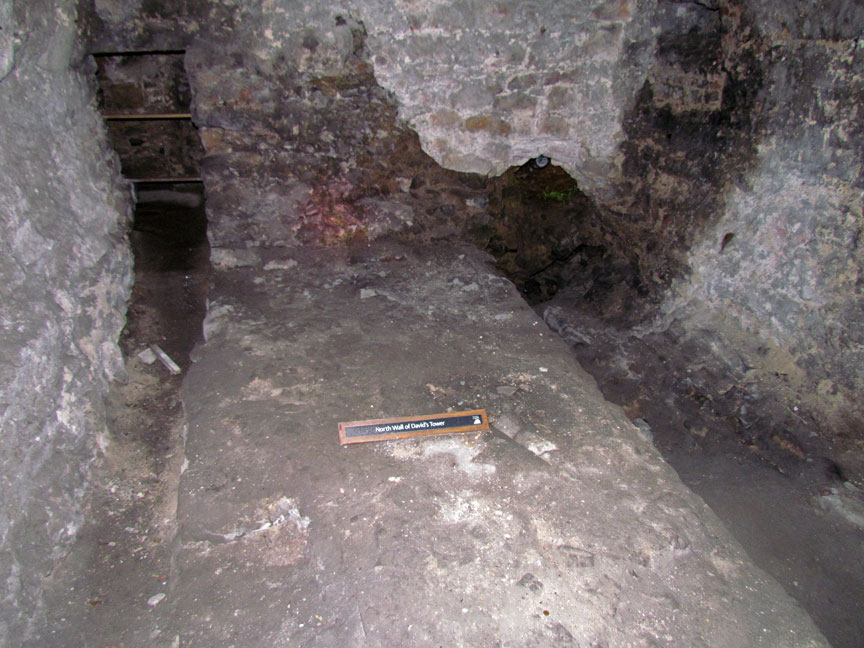
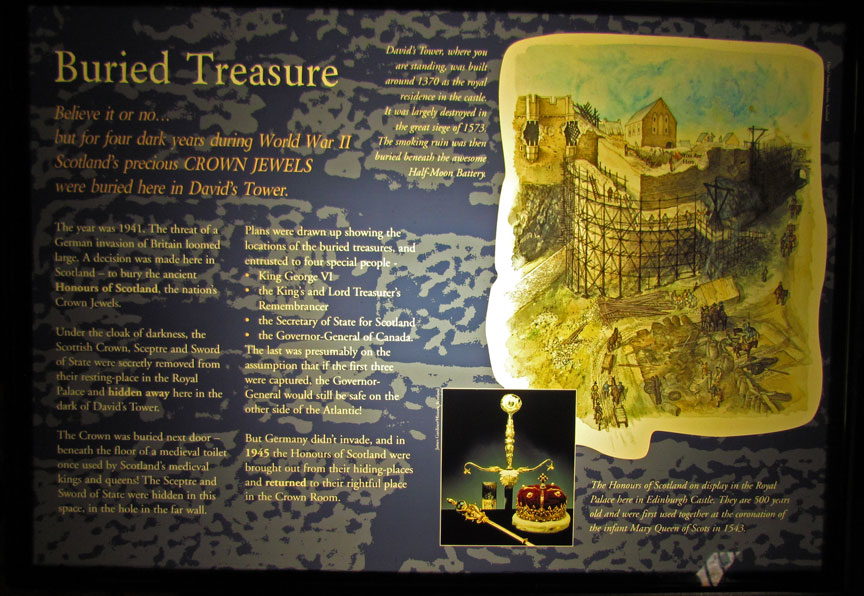
In 1479, Alexander Stewart, Duke of Albany, was imprisoned in David's Tower for
plotting against his brother, King James III (ruled 14601488). He escaped by
getting his guards drunk, then lowering himself from a window on a rope. Albany
fled to France, then England, where he allied himself with King Edward IV. In
1482, Albany marched into Scotland with Richard, Duke of Gloucester (later King
Richard III) and an English army. He occupied Edinburgh Castle and imprisoned
the King for two months before the rebellion collapsed.
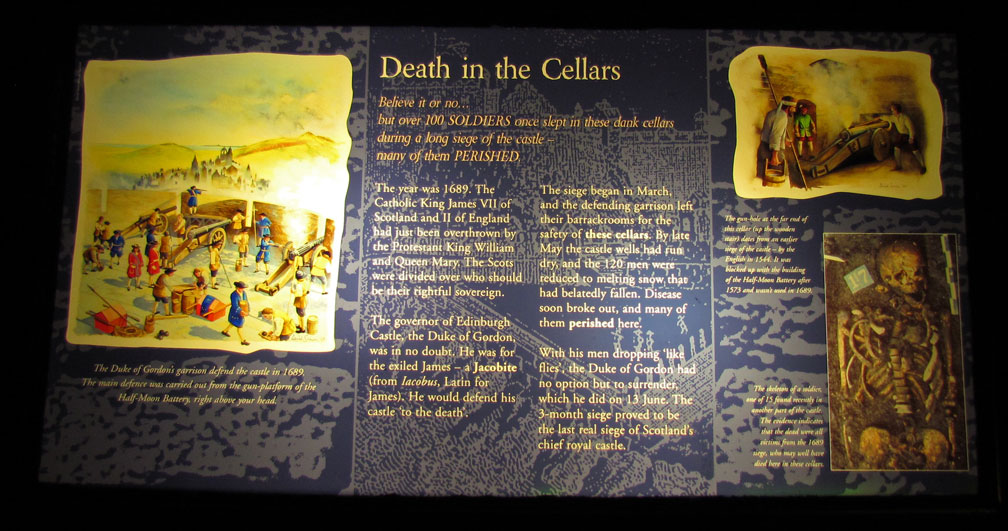
During the 15th century the castle was increasingly used as an arsenal and
armaments factory. The first known purchase of a gun was in 1384, and the "great
bombard" Mons Meg was delivered to Edinburgh in 1457. The first record of the
manufacture of guns occurs in 1474, and by 1498 the master gunner Robert
Borthwick was casting bronze guns at Edinburgh. By 1511 Edinburgh was the
principal foundry in Scotland, supplanting Stirling Castle, with Scottish and
European smiths working under Borthwick, who by 1512 was appointed "master
melter of the king's guns". Their output included guns for the Scottish
flagship, Great Michael, and the "Seven Sisters", a set of cannon captured by
the English at Flodden in 1513, which were described by a Venetian writer as
powerful and beautiful weapons. From 1510 Dutch craftsmen were also producing
hand culverins, an early firearm. After Flodden, Borthwick continued his work,
producing an unknown number of guns, of which none survive. He was succeeded by
French smiths, who began manufacturing hagbuts (another type of firearm) in the
1550s, and by 1541 the castle had a stock of 413 hagbuts.
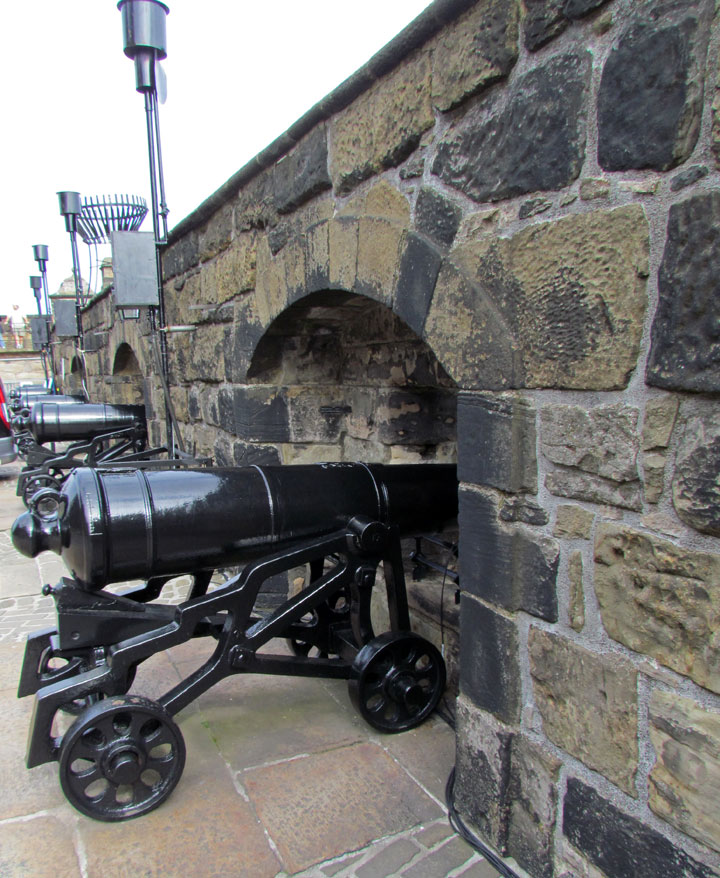
Argyle Battery
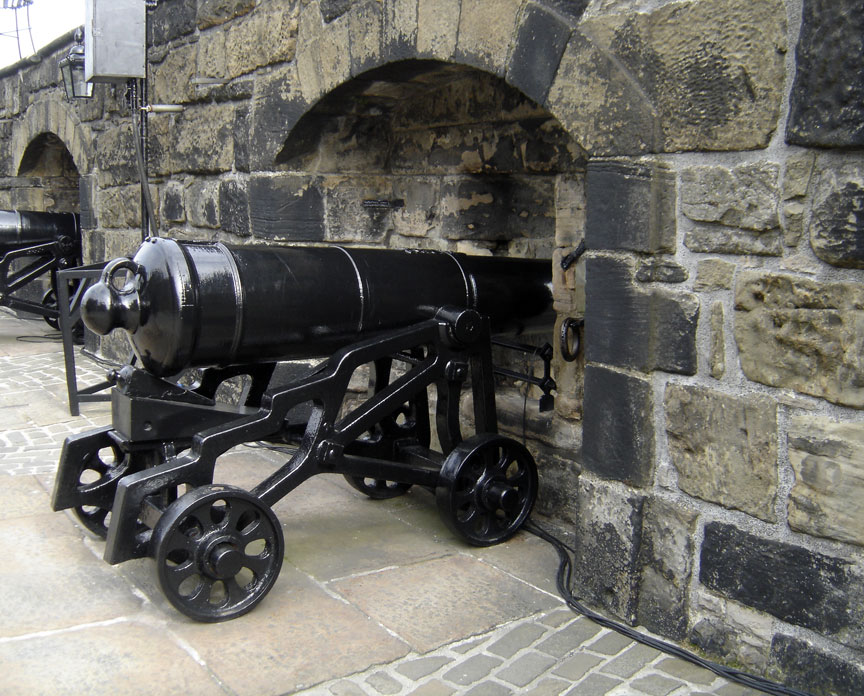
Meanwhile, the royal family began to stay more frequently at the Abbey of
Holyrood, at the opposite end of Edinburgh's "Royal Mile". Around the end of the
fifteenth century, King James IV (ruled 14881513) built Holyroodhouse, by the
abbey, for his principal Edinburgh residence, and the castle's role as a royal
home subsequently declined. James IV did, however, construct the present Great
Hall, which was completed in the early 16th century.
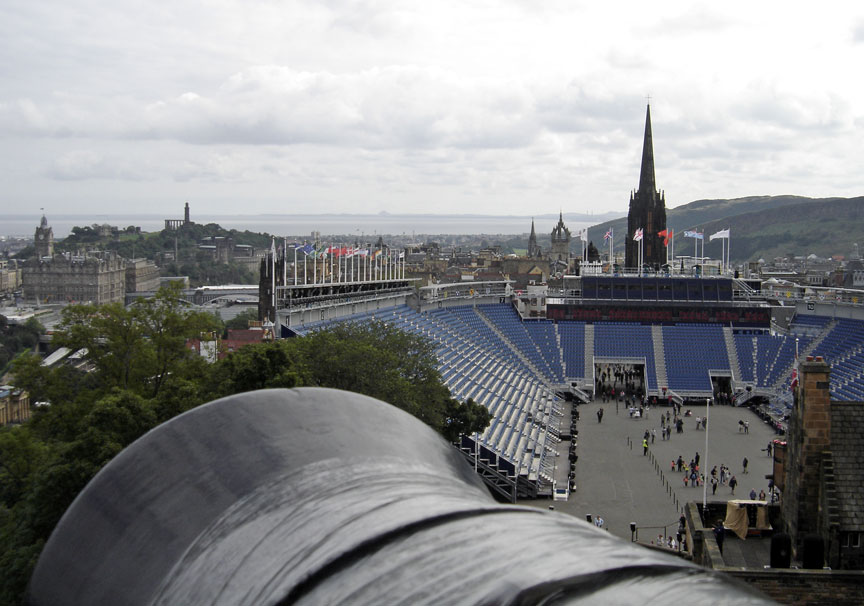

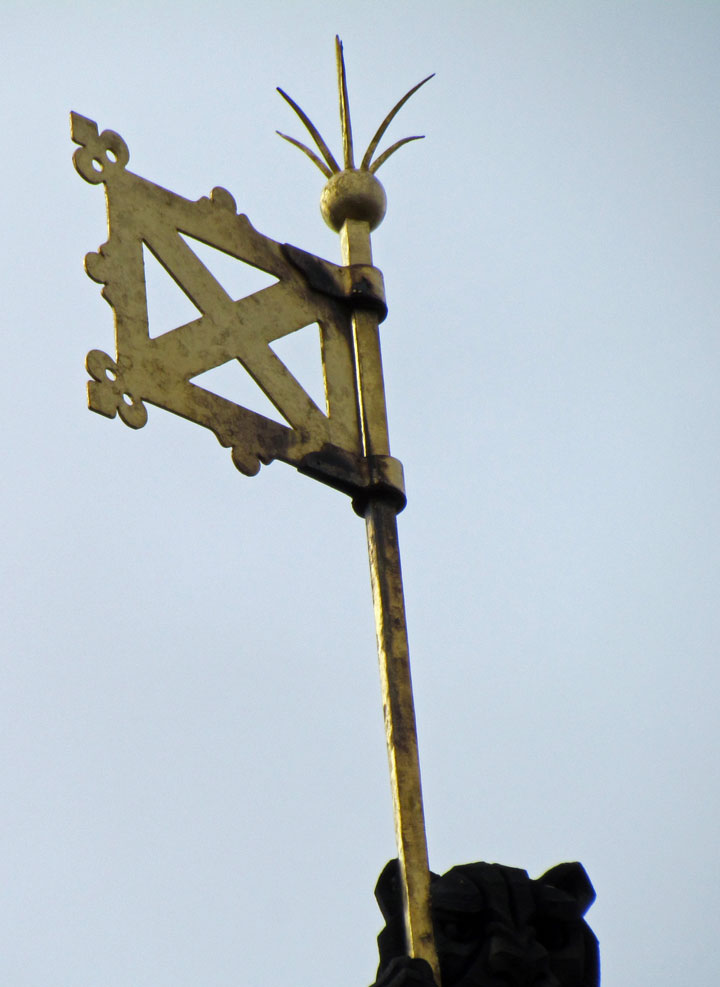
James IV was killed in battle at Flodden Field, on 9 September 1513. Expecting
the English to press their advantage, the Scots hastily constructed a town wall
around Edinburgh and augmented the castle's defences. Robert Borthwick and a
Frenchman, Antoine d'Arces, were involved in designing new artillery defences
and fortifications in 1514, although little work appears to have been carried
out. Three years later, King James V (ruled 15131542), still only five years
old, was brought to the castle for safety. Upon James' death 25 years later, the
crown passed to his week-old daughter, Mary, Queen of Scots. English invasions
followed, as King Henry VIII attempted to force a dynastic marriage on Scotland,
although Edinburgh Castle remained largely unaffected. Following these
campaigns, refortifications included an earthen angle-bastion, known as the
Spur, of the type known as trace italienne, one of the earliest examples in
Britain. It may have been designed by Migiliorino Ubaldini, an Italian engineer
from the court of Henry II of France, and was said to have the arms of France
carved on it. James V's widow, Mary of Guise, acted as regent from 1554
until her death at the castle in 1560. The following year, her daughter Mary
returned from France to begin her reign.
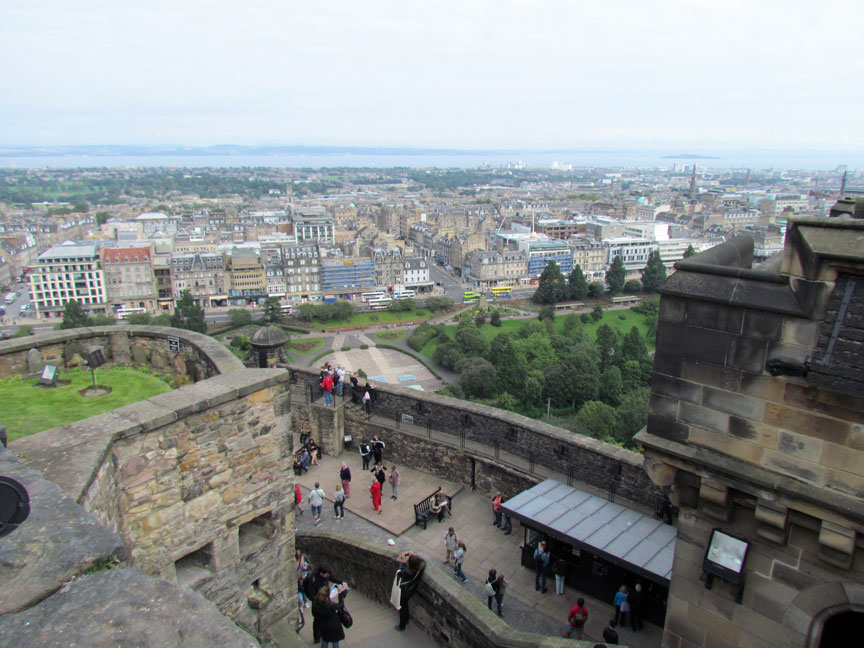
The reign of the Catholic Queen Mary was marred by crises and quarrels amongst
the powerful Protestant Scottish nobility. In 1565, the Queen married Henry
Stuart, Lord Darnley, and the following year, in a small room of the Palace at
Edinburgh Castle, she gave birth to James, who would later be King of both
Scotland and England. Mary's own reign, however, was already drawing to a close.
Three months after the murder of Darnley at Kirk o' Field in 1567, she married
James Hepburn, 4th Earl of Bothwell, one of the murder suspects. A large
proportion of the nobility rebelled, resulting ultimately in the imprisonment
and forced abdication of Mary at Loch Leven Castle. She escaped and fled to
England, and some of the nobility remained faithful to her cause. Edinburgh
Castle was initially handed by its Captain, James Balfour, to the Regent Moray,
who had forced Mary's abdication, and now held power in the name of the infant
King James VI. Moray appointed Sir William Kirkcaldy of Grange as Keeper of the
Castle.
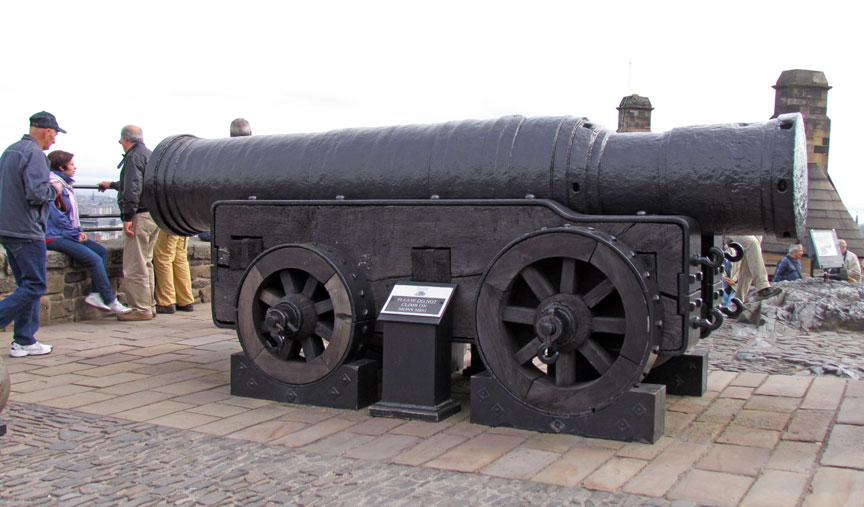
Mons Meg
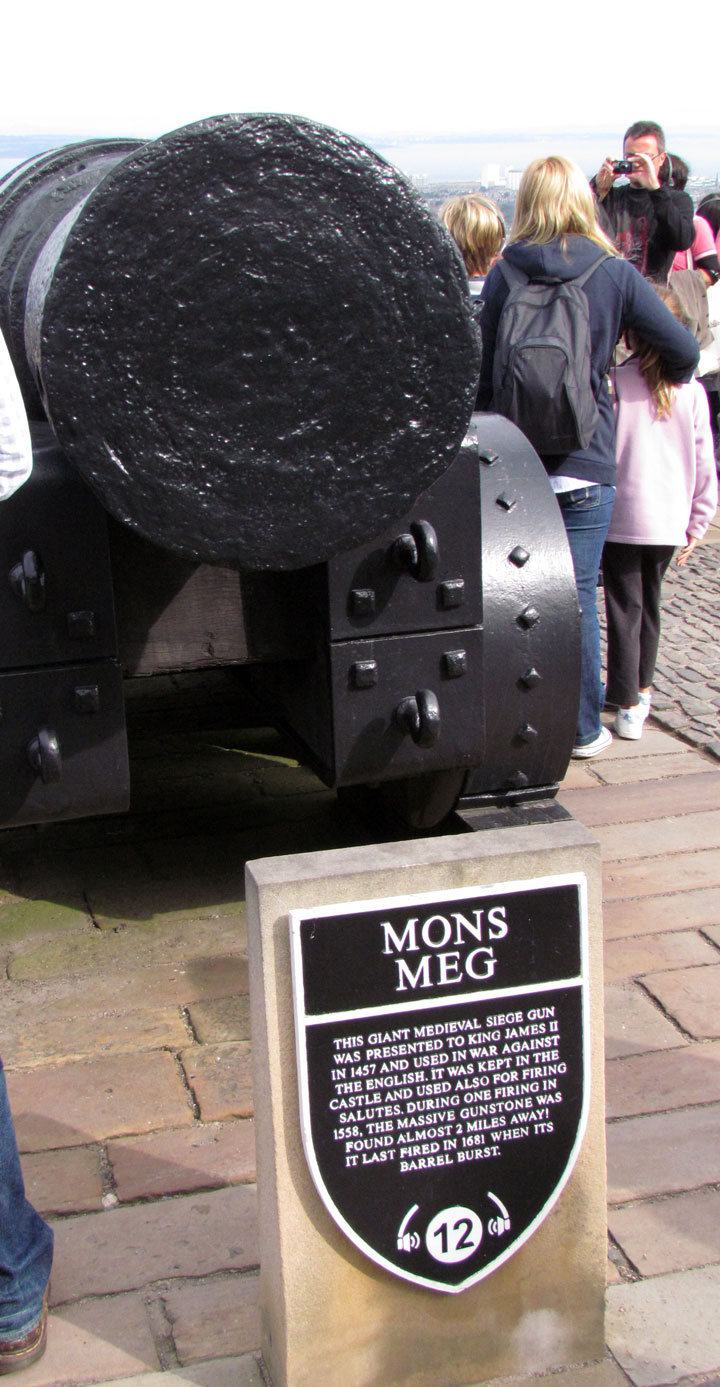
Kirkcaldy of Grange was a trusted lieutenant of the Regent, but after Moray's
murder in January 1570 his allegiance to the King's cause began to waver.
Intermittent civil war continued between the supporters of the two monarchs, and
in April 1571 Dumbarton Castle fell to the King's men. Under the influence of
William Maitland of Lethington, Mary's secretary, Grange changed sides,
occupying the town and castle of Edinburgh for Queen Mary, and against the new
regent, the Earl of Lennox. The stand-off which followed was not resolved until
two years later, and became known as the "Lang Siege", from the Scots word for
"long". Hostilities began in May, with a month-long siege of the town, and a
short second siege in October. Blockades and skirmishing continued meanwhile,
and Grange continued to refortify the castle. The King's party appealed to
Elizabeth I of England for assistance, as they lacked the artillery and money
required to reduce the castle, and feared that Grange would receive aid from
France. Elizabeth sent ambassadors to negotiate, and in July 1572 a truce was
agreed and the blockade lifted. The town was effectively surrendered to the
King's party, with Grange confined to the castle.
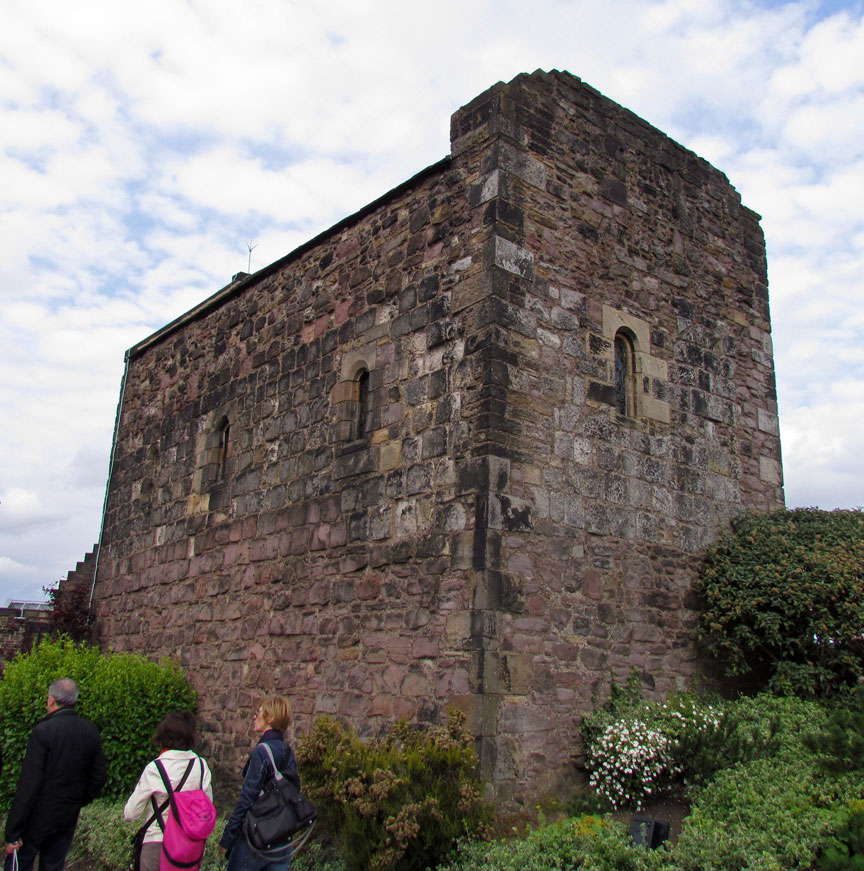
Saint Margaret's Chapel
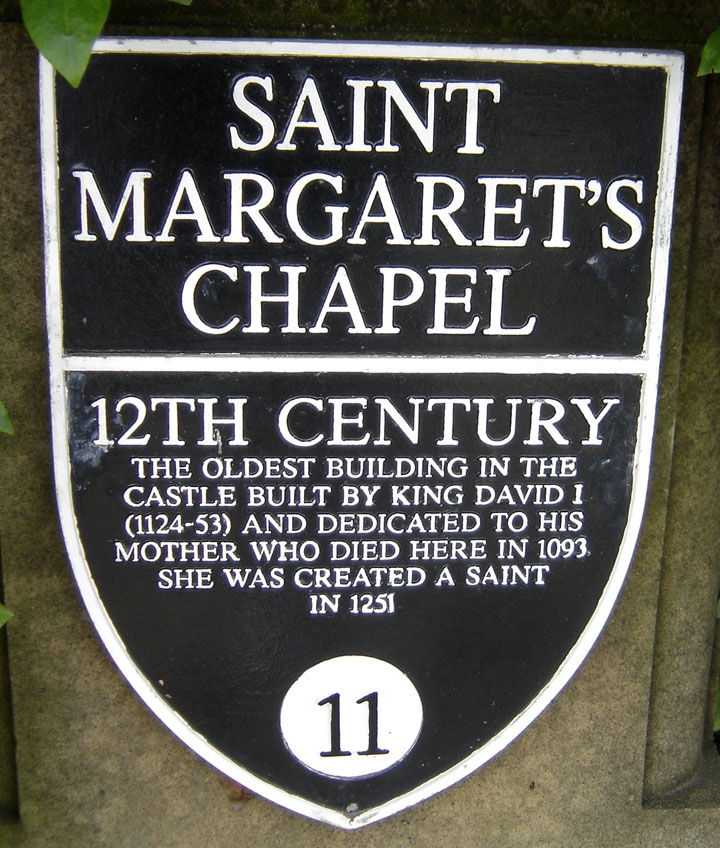
The truce ran out on 1 January 1573, and Grange began bombarding the town. His
supplies of powder and shot, however, were running low, and despite having 40
cannon available, there were only seven gunners in the garrison. The King's
forces, now with the Earl of Morton in charge as regent, were making headway
with plans for a siege. Trenches were dug to surround the castle, and St
Margaret's Well was poisoned. By February, all Queen Mary's other supporters had
surrendered to the Regent, but Grange resolved to resist, despite water
shortages within the castle. The garrison continued to bombard the town, killing
a number of citizens. They also made sorties to set fires, burning 100 houses in
the town, and then firing on anyone attempting to put out the flames.

In April, a force of around 1,000 English troops, led by Sir William Drury,
arrived in Edinburgh. They were followed by 27 cannon from
Berwick-upon-Tweed, including one that had been cast within Edinburgh Castle
and captured by the English at Flodden. The English troops built a battery on
Castle Hill, immediately facing the east walls of the castle, and five other
batteries to the north, west and south. By 17 May these were ready, and the
bombardment began. Over the next 12 days, the gunners dispatched around 3,000
shots at the castle. On 22 May, the south wall of David's Tower collapsed, and
the next day the Constable's Tower also fell. The debris blocked the castle
entrance, as well as the Fore Well, although this had already run dry. On 26
May, the English attacked and captured the Spur, the outer fortification of the
castle, which had been isolated by the collapse. The following day, Grange came
out, calling a ceasefire while surrender could be negotiated. When it was made
clear that he would not be allowed to go free, Grange resolved to continue the
resistance, but the garrison threatened to mutiny. He therefore arranged for
Drury and his men to come into the castle on 28 May, surrendering to the English
rather than to the Regent Morton. Edinburgh Castle was handed over to George
Douglas of Parkhead, the Regent's brother, and the garrison were allowed to go
free. William Kirkcaldy of Grange, his brother James, and two jewellers who had
been minting coins in Mary's name inside the castle, were hanged at the mercat
cross on 3 August.

St Margarets Gospel Book
Much of the castle was subsequently rebuilt by Regent Morton, including the Spur, the new Half Moon Battery, and the Portcullis Gate. Some of these works were supervised by William MacDowall, the master of work who fifteen years earlier had repaired David's Tower. The Half Moon Battery, while impressive in size, is considered by historians as an ineffective and dated artillery fortification. This may be due to a shortage of resources, although the battery's position: obscuring the ancient David's Tower; and enhancing the prominence of the palace, has been seen as a significant decision.

The battered palace block remained unused, particularly after James VI departed
to become King of England in 1603. James had repairs carried out in 1584, and in
16151616 more extensive repairs were carried out in preparation for his return
visit to Scotland. The mason William Wallace and master of works James Murray
introduced an early Scottish example of the double-pile block. The principal
external features were the three, three-storey oriel windows on the east faηade,
facing the town and emphasising that this was a palace rather than a place of
defence. During his visit of 1617, James held court in the refurbished palace,
but still preferred to sleep at Holyrood.

In 1621, King James granted Sir William Alexander the land in North America
between New England and Newfoundland, as Nova Scotia ("New Scotland"). To
promote the settlement and plantation of Nova Scotia, the Baronetage of Nova
Scotia was created in 1624. Under Scots Law, baronets had to "take sasine" by
symbolically receiving the earth and stone of the land of which they were
baronet. To make this possible, since Nova Scotia was far distant, the King
declared that sasine could be taken either in Nova Scotia or, alternatively, "at
the castle of Edinburgh as the most eminent and principal place of Scotland."
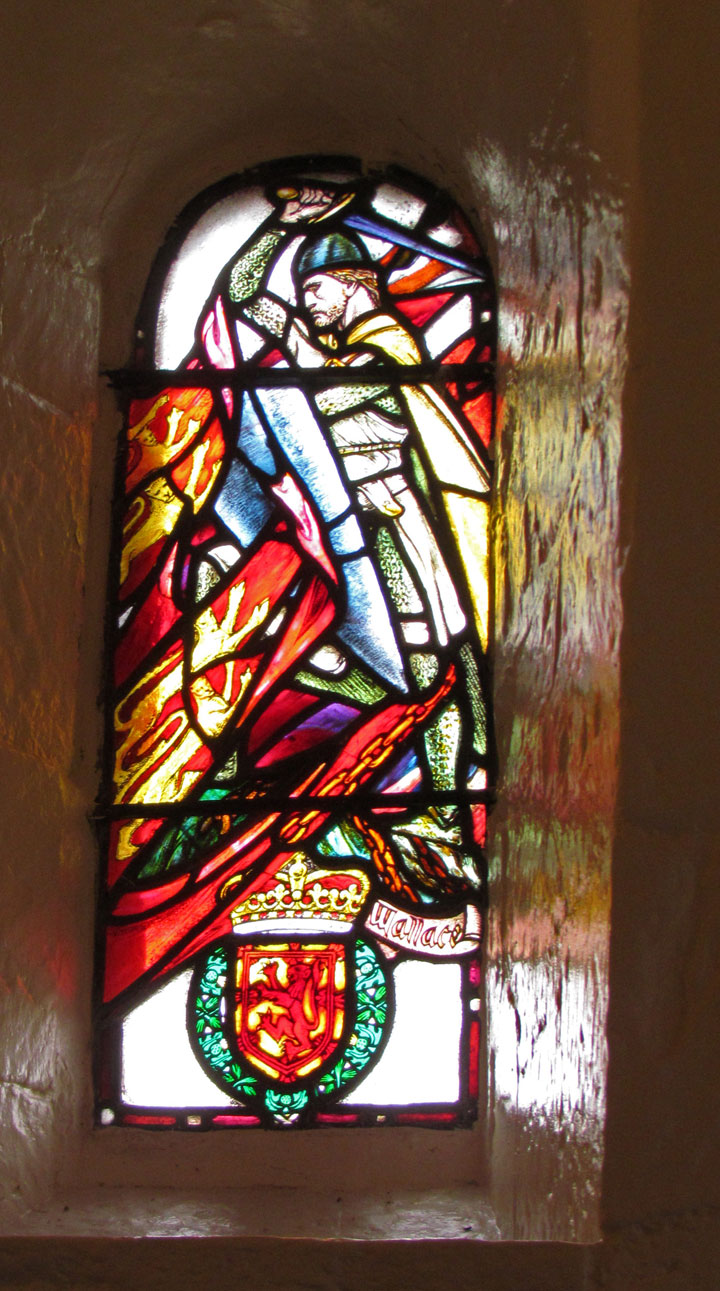
James' successor, King Charles I, visited Edinburgh Castle only once, hosting a
feast in the Great Hall, and staying the night before his coronation as King of
Scots in 1633, the last occasion that a reigning monarch has resided in the
castle. In 1639, in response to Charles' attempts to reform the Scottish Church,
civil war broke out between the King's forces and the Presbyterian Covenanters.
The Covenanters, led by Alexander Leslie, captured Edinburgh Castle after a
short siege, although it was restored to Charles after the Peace of Berwick of
June the same year. The peace was short lived, however, and the following year
the Covenanters took the castle again, this time after a three-month siege,
during which the garrison ran out of supplies. The Spur was badly damaged, and
was demolished in the 1640s. The Royalist commander James Graham, 1st Marquess
of Montrose, was imprisoned here after his capture in 1650.
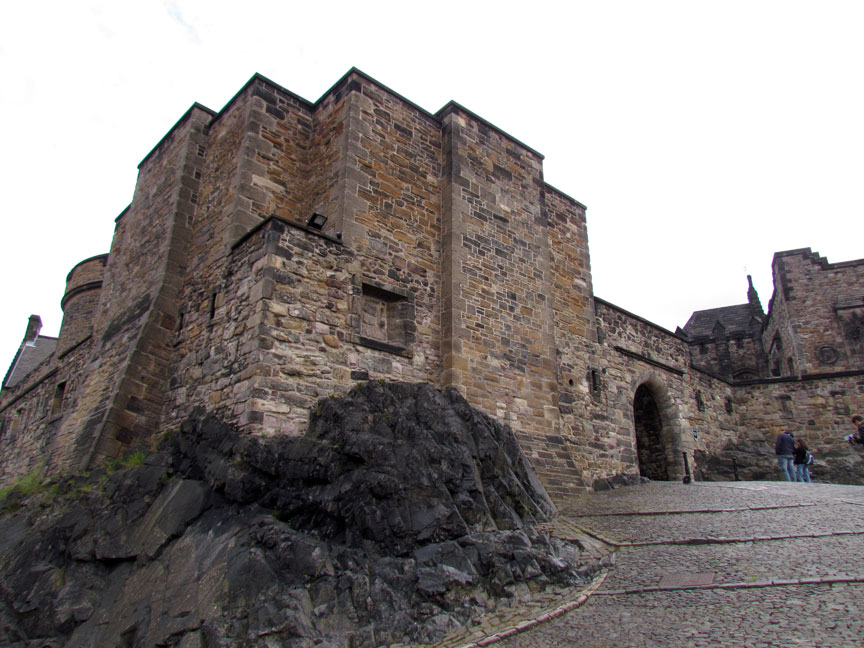
In May 1650, the Covenanters signed the Treaty of Breda, allying themselves with
King Charles II against the English Parliamentarians, who had executed King
Charles I the previous year. In response, Oliver Cromwell launched an invasion
of Scotland, defeating the Covenanter army at Dunbar in September. Edinburgh
Castle was taken after a three-month siege, which caused further damage. The
Governor of the Castle, Colonel Walter Dundas, surrendered to Cromwell despite
having enough supplies to hold out, allegedly because he wished to change sides.
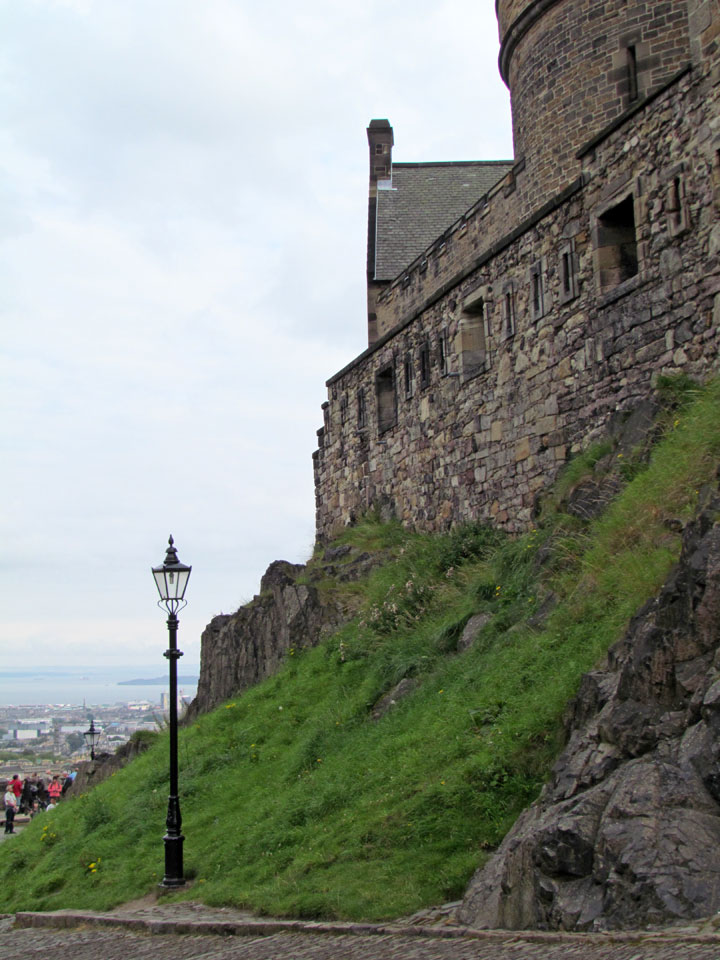
After his Restoration as King of England and Scotland in 1660, Charles II opted
to maintain a full-time standing army based on Cromwell's New Model Army. From
this time until 1923, a garrison was continuously maintained at the castle. The
medieval royal castle was transformed into a garrison fortress, but continued to
see military and political action. The Marquis of Argyll was imprisoned here in
1661, during the mopping up of the King's enemies after the Restoration. Twenty
years later, his son, the Earl of Argyll, was also imprisoned in the castle for
religious Nonconformism. He escaped by disguising himself as his sister's
footman, but was brought back to the castle after his failed rebellion against
King James VII in 1685.
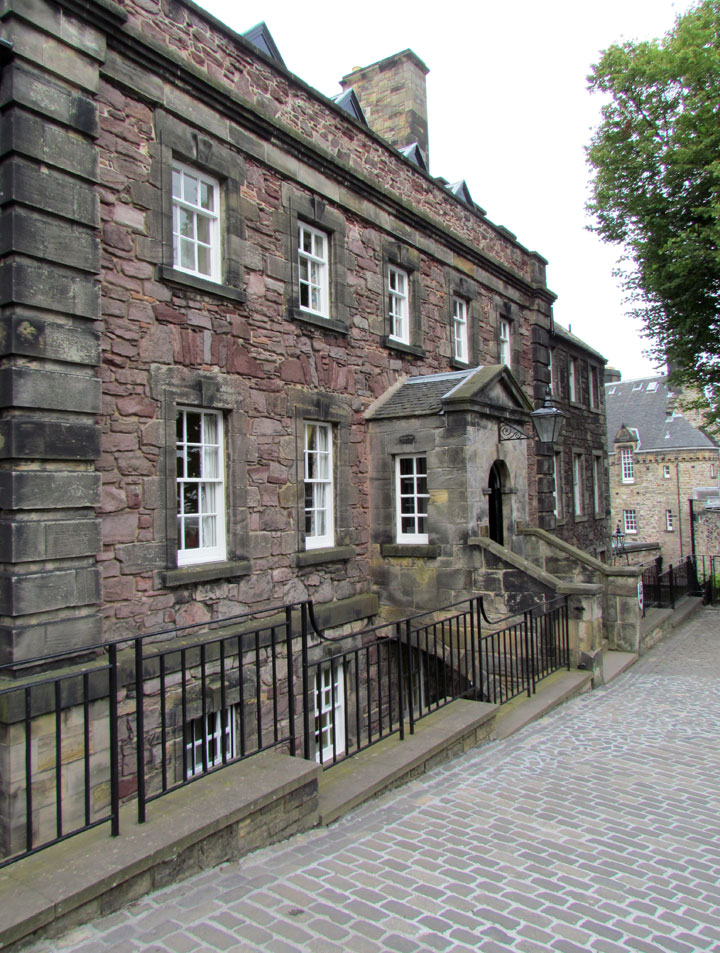
Governor's House
James VII was deposed and exiled by the Glorious Revolution of 168889, which
installed William of Orange as King of England. The Parliament of Scotland also
accepted William as their new king, and required the Duke of Gordon, Governor of
the Castle, to surrender the fortress. Gordon, who had been appointed by James
VII as a fellow Catholic, refused. In March 1689, the castle was blockaded by
7,000 troops, against a garrison of 160 men, who were further weakened by
religious disputes. On 18 March, Viscount Dundee climbed up the Castle Rock, and
attempted to persuade Gordon to ride out with him in rebellion against the new
King. Gordon chose to stay, and during the ensuing siege he refused to fire
upon the town, while the besiegers inflicted little damage on the castle.
Despite Dundee's initial successes in the north, Gordon eventually surrendered
on 14 June, due to dwindling supplies, and having lost 70 men during the
three-month siege. Under the terms of the Acts of Union, which joined England
and Scotland in 1707, Edinburgh was one of the four Scottish castles to be
maintained and permanently garrisoned by the new British Army, along with Stirling, Dumbarton and Blackness.
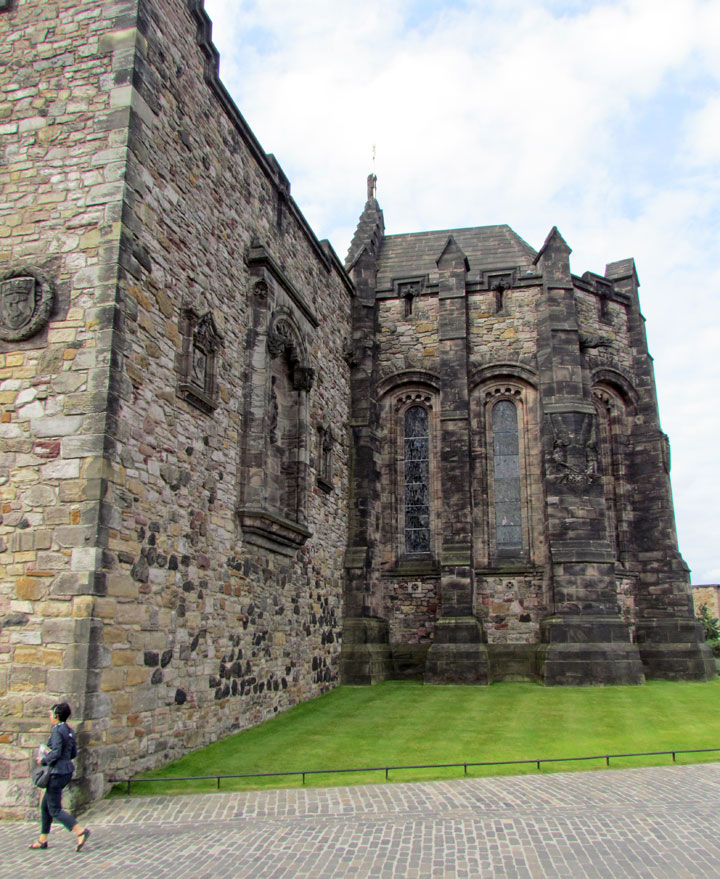
The castle was almost taken in the first Jacobite rising in support of James
Stuart, the "Old Pretender", in 1715. On 8 September, just two days after the
rising began, a party of around 100 Jacobite Highlanders, led by Lord Drummond,
attempted to scale the walls with the assistance of members of the garrison.
However, the rope ladder lowered by the castle sentries was too short, and the
alarm was raised after a change in the watch. The Jacobites fled, while the
deserters within the castle were hanged or flogged. General Wade reported in
1728 that the castle's defences were decayed and inadequate, and major
refortifications were carried out throughout the 1720s and 1730s, when most of
the artillery defences and bastions on the north and west sides of the castle
were built. These were designed by military engineer Captain John Romer, and
built by William Adam. They include the Argyle Battery, Mills Mount Battery, the
Low Defences and the Western Defences.
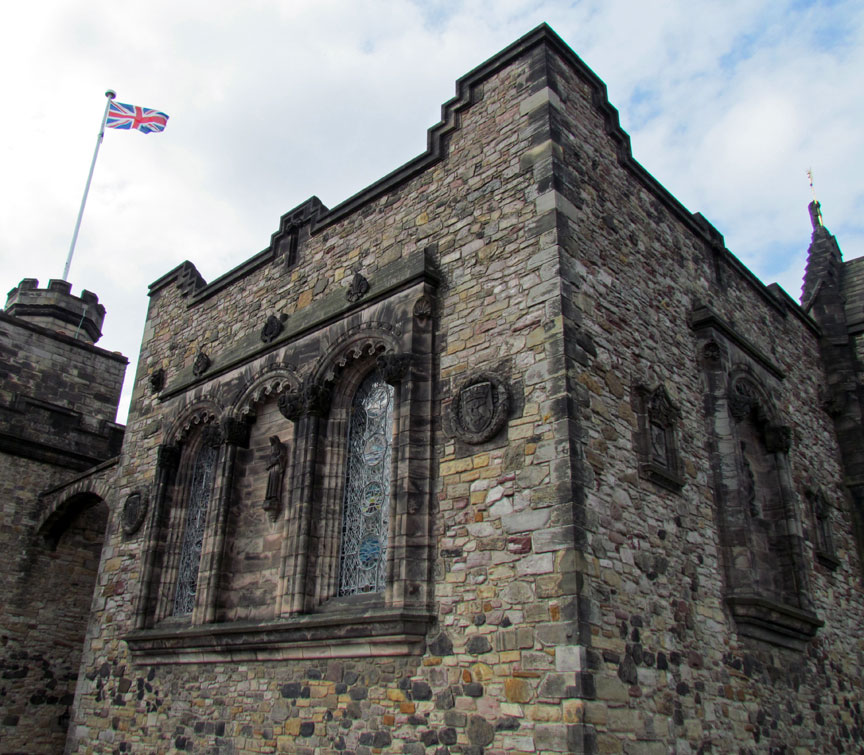
The last military action at the castle was during the second Jacobite rising of
1745. The Jacobite army, under Charles Edward Stuart ("Bonnie Prince Charlie")
captured Edinburgh without a fight in September 1745, but the castle remained in
the hands of the ageing Deputy Governor, General George Preston, who refused to
surrender.[85] After their victory over the government army at Prestonpans on 21
September, the Jacobites attempted to blockade the castle. Preston's response
was to bombard Jacobite positions within the town. After several buildings had
been demolished, and four people killed, Charles called off the blockade. The
Jacobites themselves had no heavy guns with which to respond, and by November
they had marched on to England, leaving Edinburgh to the castle garrison.

Over the next century, the castle vaults were used to hold prisoners of war
during several conflicts, including the Seven Years' War (17561763), the
American War of Independence (17751783) and the Napoleonic Wars (18031815).
During this time, several new buildings were erected within the castle,
including powder magazines, stores, the Governor's House (1742), and the New
Barracks (17961799).

A mass prison break in 1811, in which 49 prisoners of war escaped via a hole in
the south wall, persuaded the authorities that the castle vaults were no longer
a suitable prison. This use ceased in 1814, and the castle began to take on a
different role as a national monument. In 1818, Sir Walter Scott was given
permission to search the castle for the Crown of Scotland, which had been stored
away since the union of Scotland and England in 1707. Breaking open the Crown
Room, he retrieved the Honours of Scotland, which were then put on public
display, with an entry charge of one shilling. In 1822, King George IV made a
visit to Edinburgh, becoming the first reigning monarch to visit to the castle
since Charles II in 1651. In 1829, the cannon Mons Meg was returned from London,
and the palace began to be opened up to visitors during the 1830s. St Margaret's
Chapel was "rediscovered" in 1845, having been used as a store for many years.
Works in the 1880s, funded by the publisher William Nelson and carried out by
Hippolyte Blanc, saw the Argyle Tower built over the Portcullis Gate, and the
Great Hall restored after years of use as a barracks. A new gatehouse was built
in 1888. During the 19th century, several schemes were put forward for
rebuilding the whole castle as a Scottish Baronial style chβteau. Work began in
1858, but was soon abandoned, and only the hospital building was eventually
remodeled in 1897. Following the death of Prince Albert in 1861, the architect
David Bryce put forward a proposal for a 50-metre (160 ft) keep as a memorial,
although Queen Victoria objected, and the scheme was not pursued.
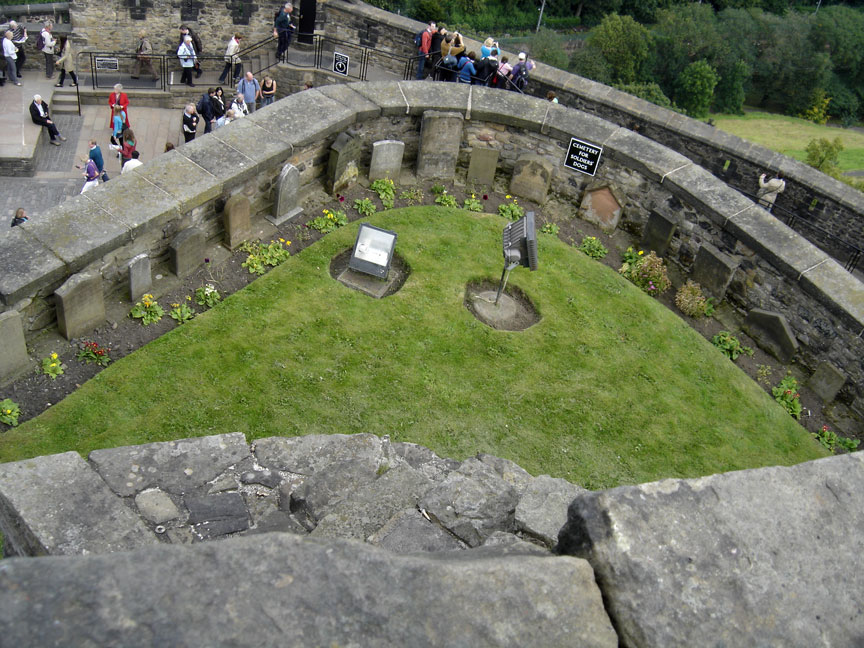

In 1905, responsibility for the castle was transferred from the War Office to
the Office of Works, although the garrison remained until 1923, when the troops
moved to Redford Barracks in south-west Edinburgh. The castle again became a
prison during the First World War, when "Red Clydesider" David Kirkwood was
confined here, and during the Second World War, when it housed German Luftwaffe
pilots. The position of Governor of Edinburgh Castle, which had been vacant
since 1876, was revived in 1935 as an honorary title for the General Officer
Commanding in Scotland, the first holder being Lieutenant-General Sir Archibald
Cameron of Lochiel. The castle passed into the care of Historic Scotland when it
was established in 1991, and was designated as a Scheduled Ancient Monument in
1993. The buildings and structures of the castle are further protected by 24
separate listings, including 13 at category A, the highest level of protection
for a historic building in Scotland. The Old and New Towns of Edinburgh, a World
Heritage Site inscribed by UNESCO in 1995, is described as "dominated by a
medieval fortress".
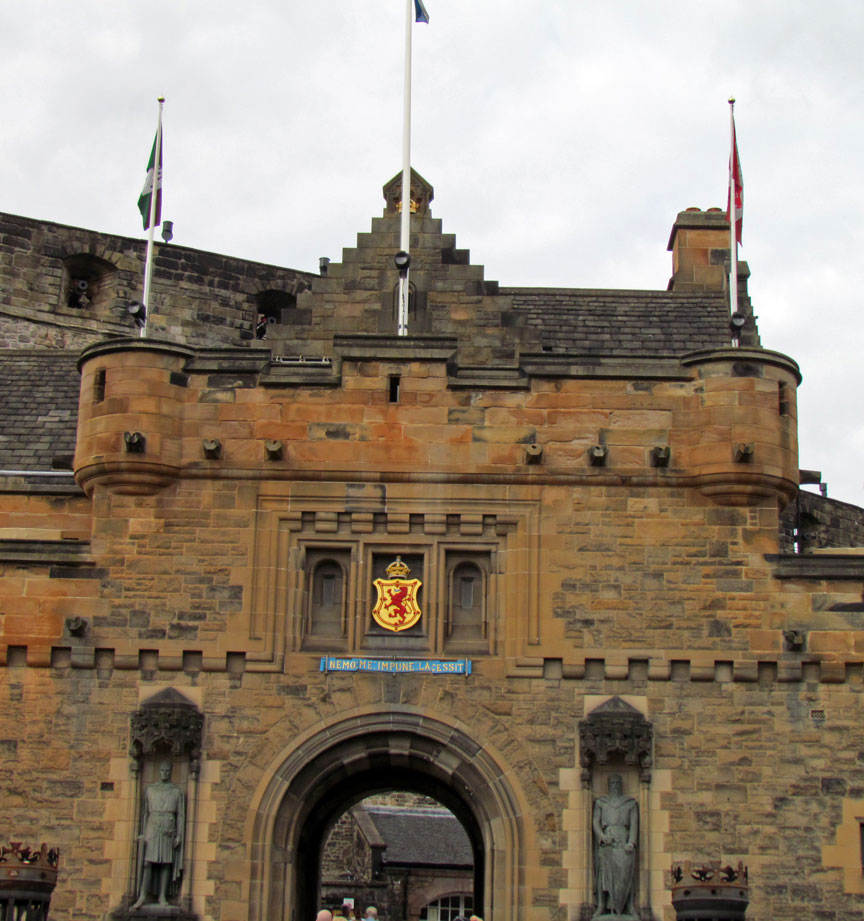
Edinburgh Castle is located at the top of the Royal Mile, at the west end of
Edinburgh's Old Town. The volcanic Castle Rock offers a naturally defended
position, with sheer cliffs to north and south, and a steep ascent from the
west. The only easy approach is from the town to the east, and the castle's
defences are situated accordingly. The castle is divided into three areas known
as "wards", separated by gates, which step up to the summit area of the Castle
Rock.
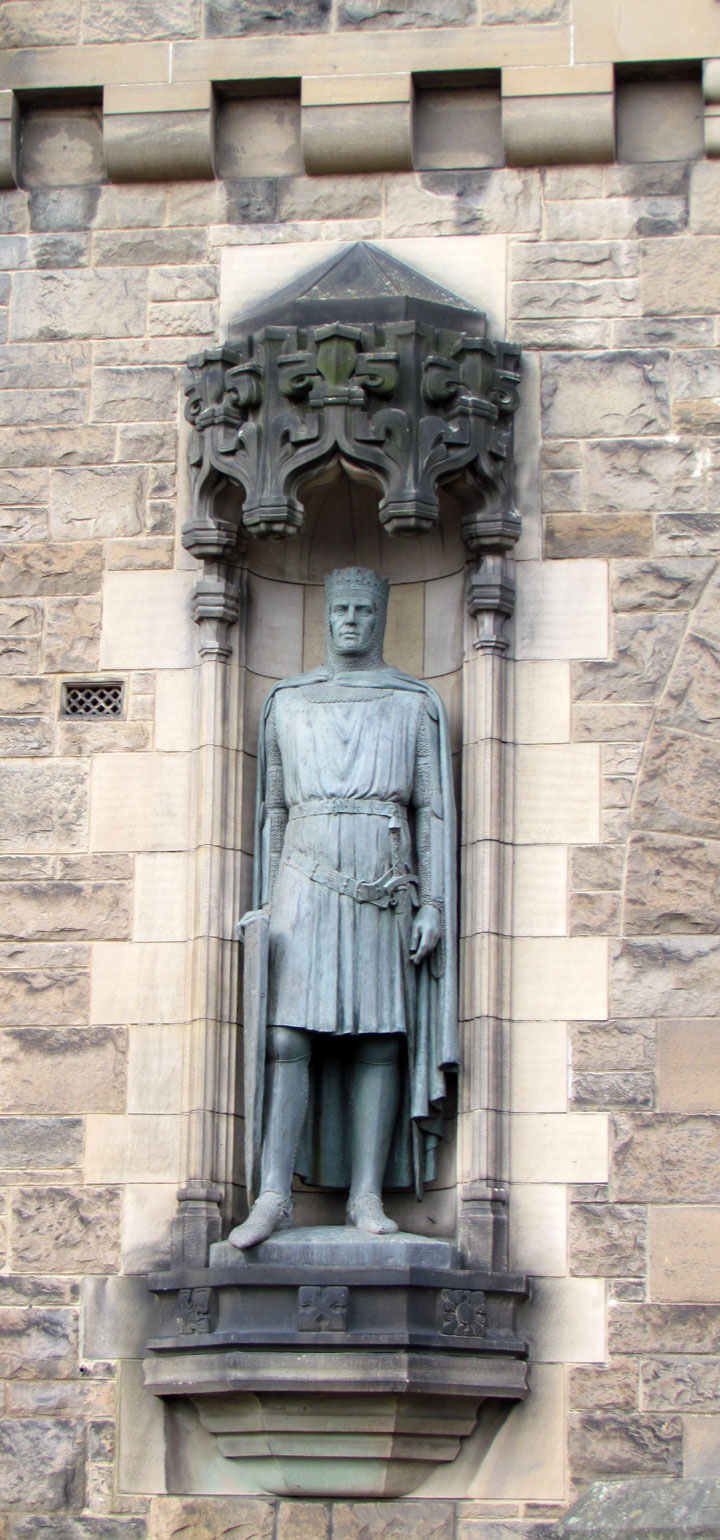
In front of the castle is a long sloping forecourt known as the Esplanade.
Originally the Spur, a 16th-century hornwork, was located here. The present
Esplanade was laid out as a parade ground in 1753, and extended in 1845. It
is upon this Esplanade that the Edinburgh Military Tattoo takes place annually.
From the Esplanade may be seen the Half Moon Battery, with the Royal Palace to
its left, and the main gate below.
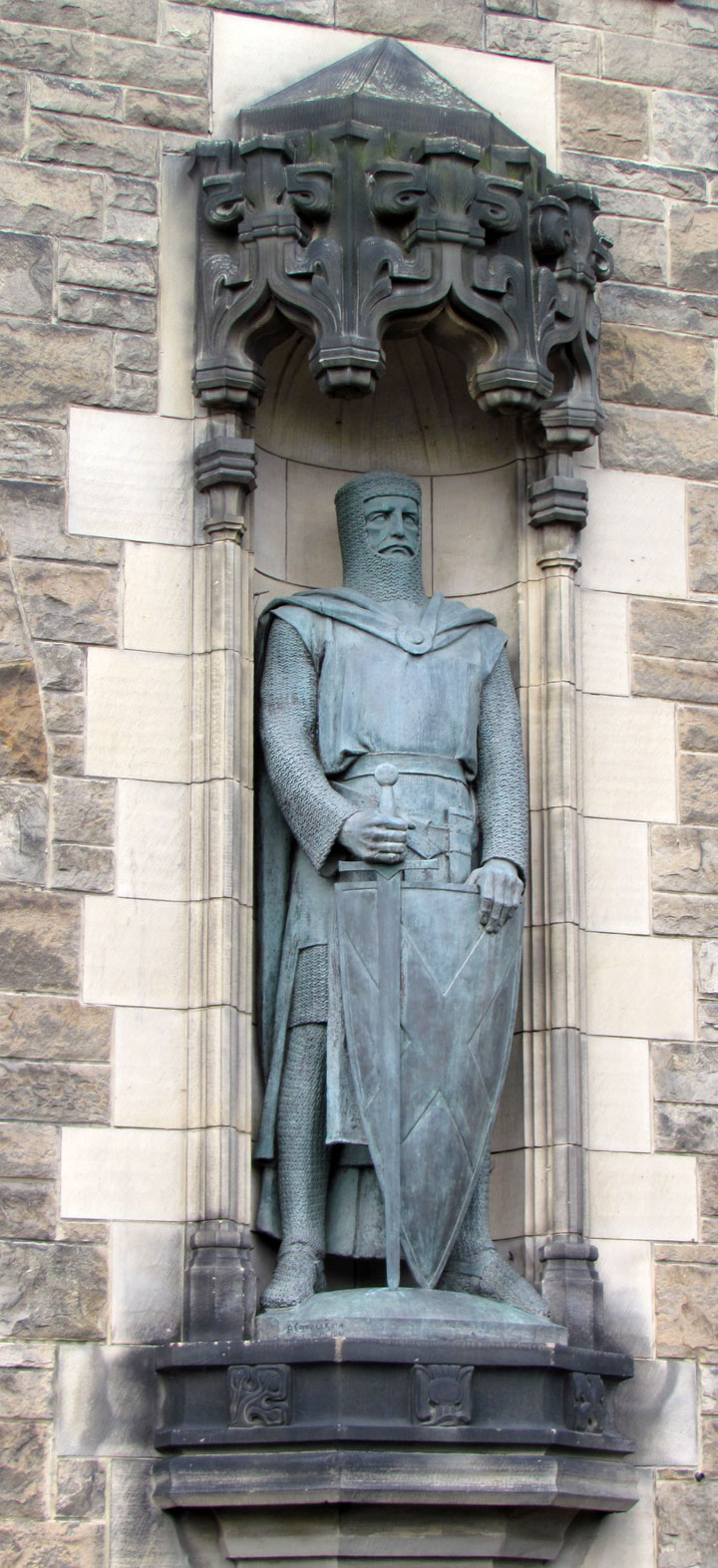
The gatehouse was built as an architecturally cosmetic addition to the castle in 1888. Statues of Robert the Bruce by Thomas Clapperton and William Wallace by Alexander Carrick were added in 1929, and the Latin motto Nemo me impune lacessit is inscribed above the gate. The dry ditch in front of the entrance was completed in its present form in 1742. Within the gatehouse are offices, and to the north is the most recent addition to the castle; the ticket office, completed in 2008 to a design by Gareth Hoskins Architects. The road, built by James III in 1464 for the transport of cannon, leads upward and around to the north of the Half Moon Battery and the Forewall Battery, to the Portcullis Gate, the entrance to the Middle Ward. In 1990, an alternative access was opened by digging a tunnel from the north of the esplanade to the north-west part of the castle, separating visitor and service traffic.

The Portcullis Gate was built by the Regent Morton after the Lang Siege of
157173 to replace the round Constable's Tower, which was destroyed in the
siege. The Portcullis Gate was rebuilt in 1584 by William Schaw, when the upper
parts were added, and again in 1750. In 1886 it was embellished by the architect
Hippolyte Blanc. Just inside the gate is the Argyle Battery overlooking Princes
Street, with Mills Mount Battery, the location of the One O'Clock Gun, to the
west. Below these is the Low Defence, while at the base of the rock is the
ruined Wellhouse Tower, built in 1362 to guard St. Margaret's Well. This natural
spring provided and important secondary source of water for the castle, the
water being lifted up by a crane mounted on a platform known as the Crane
Bastion.
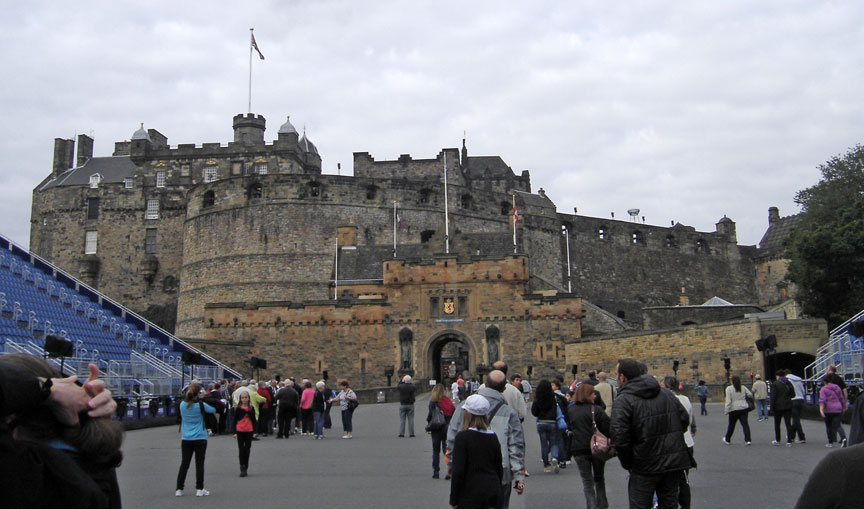
Adjacent to Mills Mount are the 18th-century cart sheds, now the tea rooms. The
Governor's House to the south was built in 1742 as accommodation for the
Governor, Storekeeper, and Master Gunner, and was used until the post of
Governor became vacant in the later 19th century; it was then used by nurses of
the castle hospital. Today, it functions as an officers' mess, and as the office
of the Governor, since the restoration of the post in 1936.
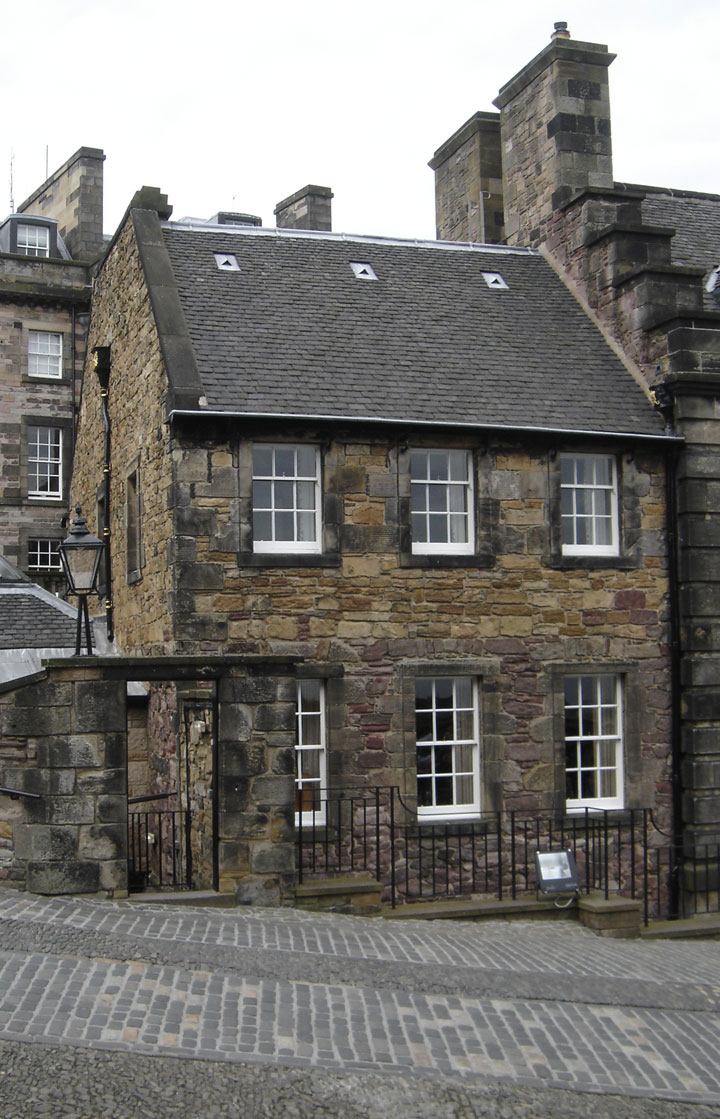
South of the Governor's House is the New Barrack Block, completed in 1799 to
house 600 soldiers, and replacing the outdated accommodation in the Great Hall.
It now houses the headquarters of the 52nd Infantry Brigade, the Regimental
Headquarters of the Royal Regiment of Scotland, and the Regimental Headquarters
and Museum of the Royal Scots Dragoon Guards (Carabiniers and Greys). The latter
was first opened in 1995 by the regiment's Colonel, Queen Elizabeth II.] Also
nearby, in the former Royal Scots drill hall, constructed in 1900, is the
regimental museum of the Royal Scots (The Royal Regiment). The military prison
was built in 1842 for the castle garrison and was extended in the 1880s. It was
last used in 1923, when the garrison moved to Redford Barracks.
[
West of the Governor's House, a store for munitions was built in 174748, and
this was later extended to form a courtyard, in which the main gunpowder
magazine also stood. In 1897 the area was remodelled as a military hospital,
formerly housed in the Great Hall. The building to the south of this courtyard
is now the National War Museum of Scotland, which forms part of the National
Museums of Scotland. It was formerly known as the Scottish United Services
Museum, and, prior to this, the Scottish Naval and Military Museum, when it was
located in the Queen Anne Building. It covers Scottish military history over the
past 400 years, and includes a wide range of military artefacts, such as
uniforms, medals and weapons. The exhibitions also illustrate the history and
causes behind the many wars in which Scottish soldiers have been involved.
Beside the museum is Butts Battery, named for the archery butts (targets)
formerly placed here. Below it are the Western Defences, where a postern gate
gives access to the western slope of the rock.
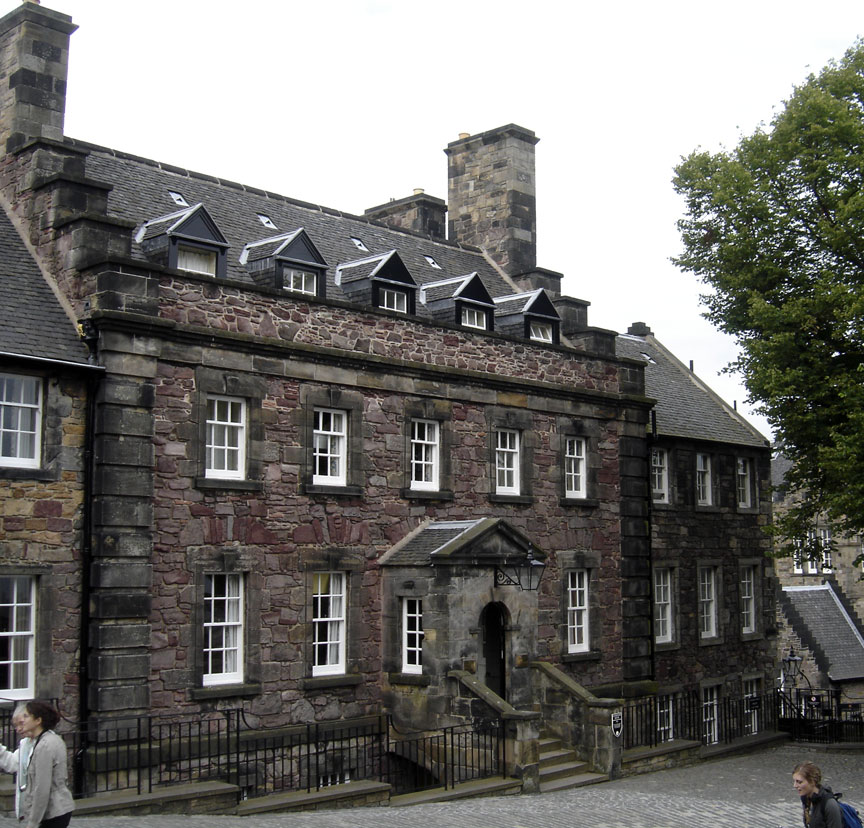
The Upper Ward occupies the highest part of the Castle Rock, and is entered from
the Middle Ward via the late 17th-century Foog's Gate. The origin of this name
is unknown, although it was formerly known as the Foggy Gate, which may relate
to the dense sea-fog, known as haar, which commonly affects Edinburgh. Adjacent
to the gates are the reservoirs, built to reduce the castle's dependency on well
water, and a former fire station, now used as a shop. The summit of the rock is
occupied by St Margaret's Chapel and the 15th-century siege gun Mons Meg. On a
ledge below this area is a small 19th-century cemetery of soldiers' and
regimental mascot dogs. Beside this, the Lang Stair leads down to the Middle
Ward, past a section of a medieval bastion, and gives access to the Argyle
Tower. The eastern end of the Upper Ward is occupied by the Forewall and Half
Moon Batteries, with Crown Square to the south.
The oldest building in the castle, and in Edinburgh, is the small St. Margaret's
Chapel. One of the few 12th-century structures surviving in any Scottish castle,
it dates to the reign of King David I (ruled 11241153), who built it as a
private chapel for the royal family and dedicated it to his mother, Saint
Margaret of Scotland, who died in the castle in 1093. It survived the slighting
of 1314, when the castle's defences were destroyed, and was used as a gunpowder
store from the 16th century, when the present roof was built. In 1845, when it
was "discovered" by the antiquary Daniel Wilson, it formed part of the larger
garrison chapel, and was restored in 18511852. The chapel is still used for
various religious ceremonies, such as weddings.

Half Moon Battery
The 15th-century siege cannon known as Mons Meg is on display outside St.
Margaret's Chapel. Mons Meg was constructed in Flanders on the orders of Philip
III, Duke of Burgundy in 1449, and was given by him to his niece's husband, King
James II in 1457. The 6-tonne (13,000 lb) bombard is displayed alongside some of
its 150-kilogram (330 lb) gun stones. On 3 July 1558, Mons Meg was fired in
salute to the marriage of Mary, Queen of Scots, to the French dauphin Franηois
II. Workmen were paid to find and retrieve the from Wardie Mure, near the River
Forth, some 2 miles (3.2 km) distant. Mons Meg has been defunct since her barrel
burst on 30 October 1681 when firing a salute for the arrival of the Duke of
Albany, the future King James VII and II.
The Half Moon Battery, which remains a prominent feature on the east side of the castle, was built as part of the reconstruction works supervised by the Regent Morton, and was erected between 1573 and 1588. The Forewall to the north was built between 1689 and 1695 to link the Half Moon to the Portcullis Tower, although part of the original wall of 1540 was incorporated into it. The Half Moon Battery was built around and over the ruins of David's Tower, two storeys of which survive beneath, with windows facing out onto the interior wall of the battery. David's Tower was built on an L-plan, the main block being 15.4 by 11.6 metres (51 by 38 ft), with a wing measuring 6.3 by 5.6 metres (21 by 18 ft) to the west. The entrance was via a pointed-arched doorway in the inner angle, although in the 16th century this was filled in to make the tower a solid rectangle. Prior to the Lang Siege, the tower was recorded as being 18 metres (59 ft) high, and the remaining portions stand up to 15 metres (49 ft) from the rock.

The tower was rediscovered in 1912, and excavations below the Half Moon Battery
revealed the extent of the surviving buildings. Several rooms are accessible to
the public, although the lower parts are generally closed. Outside the tower,
but within the battery, is a three-storey room, where large portions of the
exterior wall of the tower are still visible, showing shattered masonry caused
by the bombardment of 1573. Beside the tower, a section of the former curtain
wall was discovered, with a gun loop which overlooked the High Street: a recess
was made in the outer battery wall to reveal this gun loop. Also in 19121913,
the adjacent Fore Well was cleared and surveyed, and was found to be 33.5 metres
(110 ft) deep, and mostly hewn through the rock below the castle.
Crown Square, also known as Palace Yard, was laid out in the 15th century,
during the reign of King James III, as the principal courtyard of the castle.
The foundations were formed by the construction of a series of large stone
vaults built onto the uneven Castle Rock in the 1430s. These vaults were used as
a state prison until the 19th century, although more important prisoners were
held in the main parts of the castle. The square is formed by the Royal Palace
to the east, the Great Hall to the south, the Queen Anne Building to the west,
and the National War Memorial to the north.

The Royal Palace comprises the former royal apartments, which were the residence
of the later Stewart monarchs. It was begun in the mid 15th century, during the
reign of James IV, and it originally communicated with David's Tower. The
building was extensively remodelled for the visit of James VI to the castle in
1617, when state apartments for the king and queen were built. On the ground
floor is the Laich (low) Hall, now called the King's Dining Room, and a small
room, known as the Birth Chamber or Mary Room, where James VI was born to Mary,
Queen of Scots, in June 1566. The commemorative painted ceiling and other
decoration was added in 1617. On the first floor is the vaulted Crown Room,
built in 1615 to house the Honours of Scotland: the crown, the sceptre and the
sword of state. The Stone of Scone, upon which the monarchs of Scotland were
traditionally crowned, is also kept in the Crown Room since its return to
Scotland in 1996. To the south of the palace is the Register House, built in the
1540s to house state archives.

The Great Hall measures 29 by 12.5 metres (95 by 41.0 ft), and was the chief
place of state assembly in the castle, although there is no evidence that the
Parliament of Scotland ever met here, as is sometimes reported. Historians have
disagreed over its dating, although it is usually ascribed to the reign of King
James IV, and is thought to have been completed in the early years of the 16th
century. The decorative carved stone corbels supporting the roof have
Renaissance detailing, which has been compared to works at Blois, France, of
around 1515, indicating that the arts in Scotland were relatively advanced at
this time. It is one of only two medieval halls in Scotland with an
original hammerbeam roof.
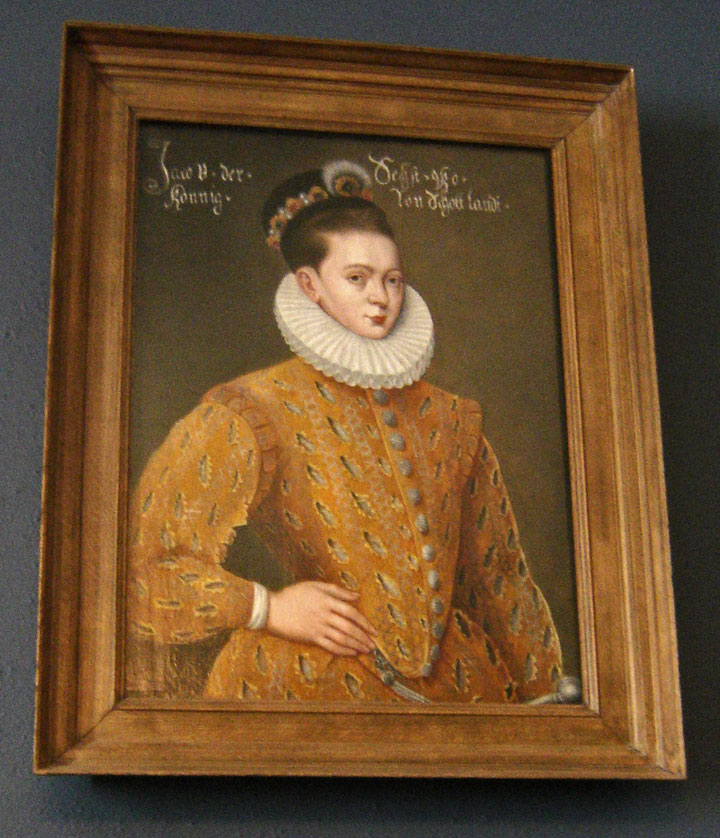
Following Oliver Cromwell's seizure of the castle in 1650, the Great Hall was
converted into a barracks for his troops, and was subdivided into three storeys
in 1737, to house 312 soldiers. Following the construction of the New Barracks
in the 1790s, it became a military hospital until 1897. It was then restored by
Hippolyte Blanc in line with contemporary ideas of medieval architecture. The
Great Hall is still sometimes used for ceremonial occasions, and is a venue on
Hogmanay for BBC Scotland's Hogmanay Live programme. To the south of the hall is
a section of 14th-century curtain wall, although with a later parapet.
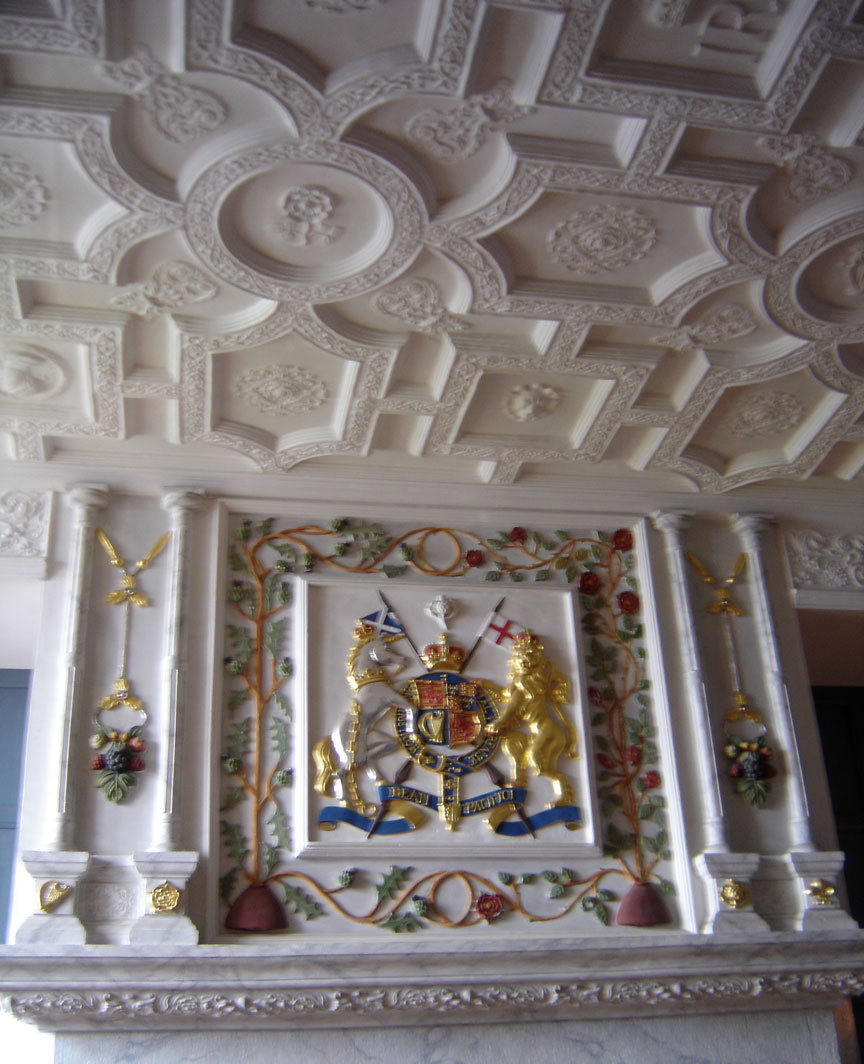
In the 16th century, this area housed the kitchens serving the adjacent Great
Hall, and was later the site of the Royal Gunhouse. The present building was
named for Queen Anne and was built during the attempted Jacobite invasion by the
Old Pretender in 1708. It was designed by Captain Theodore Dury, military
engineer for Scotland, who also designed the eponymous Dury's Battery on the
south side of the castle in 1713. The Queen Anne Building provided accommodation
for Staff Officers, but after the departure of the army it was remodeled in the
1920s as the Naval and Military Museum, to complement the newly-opened Scottish
National War Memorial. The museum later moved to the Middle Ward, and the
building now houses a function suite and an education center.
Text from Wikipedia